Current Affairs
Programme for Government
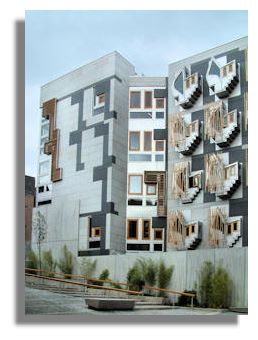 The Scottish Government this week laid out its programme for the year ahead. There are 15 bills, including proposals for replacing Council Tax with an increase in the basic rate of income tax by 3%, tackling climate change and strengthening the criminal justice system. There will be tougher legislation on the sale of alcohol and tobacco, particularly to young people, with an increase to 21 for the sale of alcohol and levying a "social responsibility" fee on pubs and clubs. The referendum on whether or not Scotland should leave the United Kingdom will not be introduced until 2010. The First Minister said he had a "single over-arching purpose to increase sustainable growth" and "that purpose is supported by our strategic objectives of building a Scotland that is safer and stronger, greener, healthier, smarter, wealthier and fairer." You can read the full statement on the programme made by the First Minister to the Scottish Parliament at Programme for Government.
The Scottish Government this week laid out its programme for the year ahead. There are 15 bills, including proposals for replacing Council Tax with an increase in the basic rate of income tax by 3%, tackling climate change and strengthening the criminal justice system. There will be tougher legislation on the sale of alcohol and tobacco, particularly to young people, with an increase to 21 for the sale of alcohol and levying a "social responsibility" fee on pubs and clubs. The referendum on whether or not Scotland should leave the United Kingdom will not be introduced until 2010. The First Minister said he had a "single over-arching purpose to increase sustainable growth" and "that purpose is supported by our strategic objectives of building a Scotland that is safer and stronger, greener, healthier, smarter, wealthier and fairer." You can read the full statement on the programme made by the First Minister to the Scottish Parliament at Programme for Government.
More Vehicles on Scotland's Roads
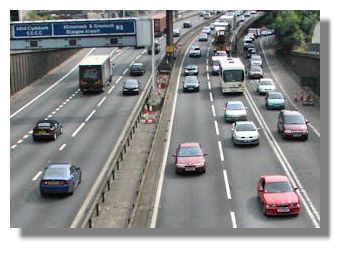 Despite soaring fuel and insurance costs, the number of vehicles on Scotland's roads continues to rise. In less than ten years the number of licensed vehicles has increased by almost a third. Scottish Government figures show that there are now 2.65 million vehicles on the roads. Although car sales have declined this year, there was a 3% increase last year in new vehicle registrations. Despite the record levels of road traffic, casualty numbers from road accidents are falling, with 10% fewer people killed and 12% fewer seriously injured. The number of passenger journeys on local bus services and the railways has also been growing - numbers using ScotRail services increased 5% last year to the highest level for 40 years. Rail passenger numbers are now 45% higher than ten years ago. The number of passengers using Scotland's air terminals also reached a new record - 25.1 million, up 3% on the previous year. Despite all those extra journeys, the statistics also report that the percentage of the population who said they had walked for pleasure or to keep fit had also increased since 1999.
Despite soaring fuel and insurance costs, the number of vehicles on Scotland's roads continues to rise. In less than ten years the number of licensed vehicles has increased by almost a third. Scottish Government figures show that there are now 2.65 million vehicles on the roads. Although car sales have declined this year, there was a 3% increase last year in new vehicle registrations. Despite the record levels of road traffic, casualty numbers from road accidents are falling, with 10% fewer people killed and 12% fewer seriously injured. The number of passenger journeys on local bus services and the railways has also been growing - numbers using ScotRail services increased 5% last year to the highest level for 40 years. Rail passenger numbers are now 45% higher than ten years ago. The number of passengers using Scotland's air terminals also reached a new record - 25.1 million, up 3% on the previous year. Despite all those extra journeys, the statistics also report that the percentage of the population who said they had walked for pleasure or to keep fit had also increased since 1999.
World Haggis Eating Championship
Maybe news item on the "World Haggis Eating Championship" should be in the sports section or even the entertainment section of this newsletter - but maybe not... Competitors from around the globe turned up at the 125th Birnam Highland Games in Perthshire to eat a pound of traditional haggis (made from sheep innards, oatmeal, and spices) in the fastest time. The winner was a local man, Willie Robertson from nearby Dunkeld who downed it all in two minutes and five seconds. Willie won the contest four years ago and walked (staggered?) away with a trophy and a bottle of whisky. One of the contestants, who has been trying for the title for the past three years, is the son of the mayor of Livermore in California. He has vowed not to stop until he wins. The contest is made even more difficult because only plastic knives and forks are supplied - and sometimes they break. A can of beer is provided to aid digestion, but that could be more of a hindrance than a benefit....
Pink Tartan Blossoms for Japan
 A designer, who has previously created tartan for ten European countries including Poland, France and Norway, has now come up with one for Japan. The design by David McGill from Edinburgh is named "Sakura" - the Javanese word for cherry blossom. So it is predominantly pink with white, green and brown. The inspiration was not just cherry blossom, but Fraserburgh-born Thomas Glover (1838-1911), the "Scottish Samurai" who did much to establish modern industrialisation in Japan. There are now an estimated 7,000 different tartans, with 150 new designs being created every year.
A designer, who has previously created tartan for ten European countries including Poland, France and Norway, has now come up with one for Japan. The design by David McGill from Edinburgh is named "Sakura" - the Javanese word for cherry blossom. So it is predominantly pink with white, green and brown. The inspiration was not just cherry blossom, but Fraserburgh-born Thomas Glover (1838-1911), the "Scottish Samurai" who did much to establish modern industrialisation in Japan. There are now an estimated 7,000 different tartans, with 150 new designs being created every year.
Ferry Service to Belgium Ends
The "Superfast" ferry service from Rosyth in Fife to Zeebrugge in Belgium began in May 2002 as the only direct ferry route between Scotland and mainland Europe. Initially there were two roll-on, roll-off ferries carrying up to 620 passengers, 115 cars, caravans and motorcycles and 110 lorries. The former Royal Navy base at Rosyth was converted into a ferry terminal and there were high hopes of success. But only three years later, as the anticipated take-up by freight transport companies failed to materialise, the service was cut to every second day. Then, earlier this year, the Greek company running the service announced that it was withdrawing totally as the route was unprofitable. The final service sailed last Saturday, after carrying nearly a million passengers and 4.2 million tonnes of freight. Strenuous efforts had been made to find another operator and this week it was announced that ferry firm Norfolkline will operate the Rosyth to Zeebrugge route - but will not start operations until next spring. Norfolkline, is part of the A.P. Møller-Mærsk Group based in Denmark.
Scotland's Oldest Bank Succumbs
 Bank of Scotland was established in 1695 by an act of the Scottish Parliament. In 2001 it merged with Halifax, Britain’s largest mortgage provider, to form HBOS - a move which also put it in the top league of world banks. But this week it was forced into being taken over by Lloyds TSB to create a banking colossus that in normal times would never have been allowed by the competition authorities - the new bank will have a 28% of all mortgage loans in the UK, more than twice its nearest rival. However, the merger is even said to have been pushed by the UK Prime Minister, Gordon Brown as HBOS faced an unprecedented fall in the value of its shares, crashing from 308.5p on 9 September to a low of just 88p - though it recovered slightly from that level. Analysts said that HBOS needed to refinance over £100 billion of funding in the next few months, which was quite a challenge after the financial turmoil and the lack of confidence in the market after the collapse of Lehman brothers. The bank claimed it was "very confident" about its funding position, pointing to its £258 billion of retail deposits for 15 million savers as the UK's largest savings institution. But credit rating agency Standard & Poor downgraded HBOS and billions were wiped off its market value.
Bank of Scotland was established in 1695 by an act of the Scottish Parliament. In 2001 it merged with Halifax, Britain’s largest mortgage provider, to form HBOS - a move which also put it in the top league of world banks. But this week it was forced into being taken over by Lloyds TSB to create a banking colossus that in normal times would never have been allowed by the competition authorities - the new bank will have a 28% of all mortgage loans in the UK, more than twice its nearest rival. However, the merger is even said to have been pushed by the UK Prime Minister, Gordon Brown as HBOS faced an unprecedented fall in the value of its shares, crashing from 308.5p on 9 September to a low of just 88p - though it recovered slightly from that level. Analysts said that HBOS needed to refinance over £100 billion of funding in the next few months, which was quite a challenge after the financial turmoil and the lack of confidence in the market after the collapse of Lehman brothers. The bank claimed it was "very confident" about its funding position, pointing to its £258 billion of retail deposits for 15 million savers as the UK's largest savings institution. But credit rating agency Standard & Poor downgraded HBOS and billions were wiped off its market value.
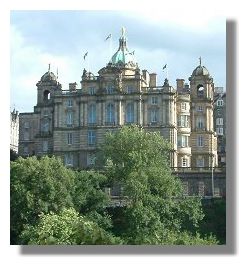 The take-over means the loss of a prestigious corporate banking HQ in Edinburgh (pictured here) and big losses for long-term shareholders, including pension funds, who have seen HBOS shares slump from over 1000p less than 18 months ago to a likely takeover price of around 200p depending on the value of Lloyds TSB shares. The take-over also poses a threat to the jobs of tens of thousands of staff in administration functions and in the branch network where the two banks overlap. HBOS has more than 17,000 staff in Scotland, while Lloyds TSB employs more than 7,000. The combined staff of the banks across the UK would be around 140,000. It is understood that the Bank of Scotland will retain its building on The Mound in Edinburgh as its Scottish HQ and will continue to issue its own banknotes and the branches will continue to be branded as Bank of Scotland. The take-over means the loss of a prestigious corporate banking HQ in Edinburgh (pictured here) and big losses for long-term shareholders, including pension funds, who have seen HBOS shares slump from over 1000p less than 18 months ago to a likely takeover price of around 200p depending on the value of Lloyds TSB shares. The take-over also poses a threat to the jobs of tens of thousands of staff in administration functions and in the branch network where the two banks overlap. HBOS has more than 17,000 staff in Scotland, while Lloyds TSB employs more than 7,000. The combined staff of the banks across the UK would be around 140,000. It is understood that the Bank of Scotland will retain its building on The Mound in Edinburgh as its Scottish HQ and will continue to issue its own banknotes and the branches will continue to be branded as Bank of Scotland.
Historical Affairs
Preserving Scotland's Military History
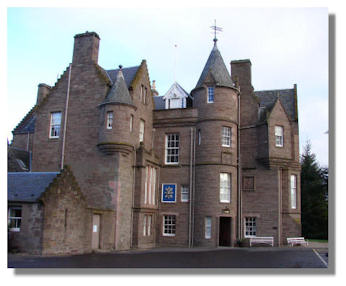 An appeal has been launched to allow the trustees of the Black Watch Regimental Museum to buy Balhousie Castle in Perth (seen here), where it is housed. The Ministry of Defence wants to sell the castle and over £3 million is needed to purchase the building and develop it. The castle dates back to the 15th century and in 1962 it became the regimental headquarters of the Black Watch and its regimental museum. The museum does an excellent job of showing the story of the regiment from its founding in 1739, through all the major conflicts in which the Black Watch participated - right up to the present day, when it was merged in 2006 (with the other Scottish regiments) into the Royal Regiment of Scotland, becoming a battalion in that unit. The museum trustees want to expand the facilities to ensure that the history of The Black Watch is preserved for future generations. See Black Watch Appeal.
An appeal has been launched to allow the trustees of the Black Watch Regimental Museum to buy Balhousie Castle in Perth (seen here), where it is housed. The Ministry of Defence wants to sell the castle and over £3 million is needed to purchase the building and develop it. The castle dates back to the 15th century and in 1962 it became the regimental headquarters of the Black Watch and its regimental museum. The museum does an excellent job of showing the story of the regiment from its founding in 1739, through all the major conflicts in which the Black Watch participated - right up to the present day, when it was merged in 2006 (with the other Scottish regiments) into the Royal Regiment of Scotland, becoming a battalion in that unit. The museum trustees want to expand the facilities to ensure that the history of The Black Watch is preserved for future generations. See Black Watch Appeal.
Genealogist's Treasure Trove
 An on-line database has been launched with the names of four million Britons, many of them Scots, who sailed to Canada in the 19th and 20th centuries to seek a new life in one of the largest-scale migrations in Britain's history. The records also include many holidaymakers and travellers, businesspeople, crew members and historical figures such as foreign leaders, scientists and celebrities. They include Alexander Graham Bell, who emigrated from Edinburgh to Ontario in 1870 to continue working on his invention of the telephone. And Falkirk-born Tommy Douglas, who moved with his family to Winnipeg in 1910 and later founded Canada's universal public healthcare. 150,000 foster children sent overseas alone as part of the Child Emigration Scheme at the end of the 19th and start of the 20th centuries are also included. The database is fully indexed and searchable, with information including passengers' first and last names, estimated birth years, years of arrival, ports of arrival and departure, ship names, occupations and final destinations in Canada. See the Ancestry.com site.
An on-line database has been launched with the names of four million Britons, many of them Scots, who sailed to Canada in the 19th and 20th centuries to seek a new life in one of the largest-scale migrations in Britain's history. The records also include many holidaymakers and travellers, businesspeople, crew members and historical figures such as foreign leaders, scientists and celebrities. They include Alexander Graham Bell, who emigrated from Edinburgh to Ontario in 1870 to continue working on his invention of the telephone. And Falkirk-born Tommy Douglas, who moved with his family to Winnipeg in 1910 and later founded Canada's universal public healthcare. 150,000 foster children sent overseas alone as part of the Child Emigration Scheme at the end of the 19th and start of the 20th centuries are also included. The database is fully indexed and searchable, with information including passengers' first and last names, estimated birth years, years of arrival, ports of arrival and departure, ship names, occupations and final destinations in Canada. See the Ancestry.com site.
Entertainment
Thunder in the Glens
 Nearly 2,000 Harley Davidson motorcycles roared into Aviemore a couple of weekends ago. It was the most successful "Thunder in the Glens" event ever as bikers from as far away as Germany and Ireland turned up to meet other enthusiasts. All the bikers rode out of Aviemore in a mass exodus to Grantown, about 15 miles away, watched by crowds of onlookers. Aviemore's hostelries were packed out and hundreds attended music events at the rally’s main base at the Macdonald Aviemore Highland Resort. Two Harley Davidson fans took their machines on the funicular railway to the Ptarmigan Restaurant and got married at the top of the Cairn Gorm mountain. The event wasn't all about paying homage to the Harley Davidson machine, however - the bikers raised around £20,000 for charity from auctions and raffles throughout the weekend.
Nearly 2,000 Harley Davidson motorcycles roared into Aviemore a couple of weekends ago. It was the most successful "Thunder in the Glens" event ever as bikers from as far away as Germany and Ireland turned up to meet other enthusiasts. All the bikers rode out of Aviemore in a mass exodus to Grantown, about 15 miles away, watched by crowds of onlookers. Aviemore's hostelries were packed out and hundreds attended music events at the rally’s main base at the Macdonald Aviemore Highland Resort. Two Harley Davidson fans took their machines on the funicular railway to the Ptarmigan Restaurant and got married at the top of the Cairn Gorm mountain. The event wasn't all about paying homage to the Harley Davidson machine, however - the bikers raised around £20,000 for charity from auctions and raffles throughout the weekend.
Picture of Harley Davidson via Wikipedia.
The Wee Book Festival
Edinburgh's Book Festival in Charlotte Square attracts many of the big names in literature, politics and entertainment. But Scotland's "other book festival" in the Dumfriesshire town of Wigtown has an ambitious line-up of its own. The town launched its first festival ten years ago to assist in the regeneration of an ailing economy. Last year it attracted 8,000 people to its events. But it is the 20 book-related businesses (including Scotland's largest second-hand bookshop) that prop up the local economy on a year-round basis. The book festival (running from 26 September to 5 October) has a star-studded line-up, including appearances from of Fay Weldon, James Kelman, A.L. Kennedy and Sir Menzies Campbell, the former Liberal Democrat leader. And there is also a performance by Scottish Opera. Princess Anne will also be paying a visit to thank the town's army of volunteers as well as ferry company Stenna Line which is sponsoring the event for three years.
T in the Park Named Festival of the Year
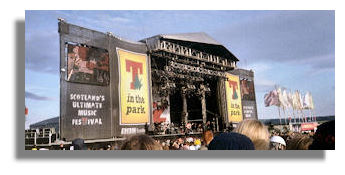 The Vodafone Live Music Awards this week named the T in the Park rock festival at Balado near Kinross as the "festival of the year". And Scottish group Primal Scream received Best Live Act and Outstanding Contribution to Live Music prizes. This was the 15th year of the popular T in the Park rock festival which is Scotland's biggest event of this kind. This year it had 114 bands on six stages over more than three days of performances
The Vodafone Live Music Awards this week named the T in the Park rock festival at Balado near Kinross as the "festival of the year". And Scottish group Primal Scream received Best Live Act and Outstanding Contribution to Live Music prizes. This was the 15th year of the popular T in the Park rock festival which is Scotland's biggest event of this kind. This year it had 114 bands on six stages over more than three days of performances
Gaelic TV Launched
Friday saw the launch of Scotland's new Gaelic TV station, BBC Alba with a mix of drama and factual and children's programmes. On the first night (it broadcasts only from 5pm to 11pm each evening) there was a live concert from Skye and an original drama called Eibheas, set in 1970s Lewis, starring Greg Hemphill as Elvis - his character speaks in English. It is hoped that the channel will appeal to a wider audience than the 60/80,000 Gaelic speakers in Scotland. But it will struggle initially as it can only be viewed on digital satellite or cable channels. It will not be shown on the most popular digital system, Freeview, until at least 2010.
|
Rampant Scotland Newsletter is also available by e-mail! Just send an e-mail to Scottie with "Subscribe Newsletter" as the subject line and a text version of these Scottish snippets of news will arrive in your mailbox on a regular basis!
 January 2008
January 2008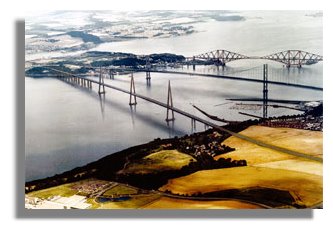 Scotland's biggest construction project for a generation, costing between £3.25 billion and £4.22 billion, has been announced by the Scottish Government's Finance Minister. The decision brings to an end speculation about a possible tunnel under the river Forth. A new crossing is needed because the cables on the present bridge (opened only in 1964) have corroded and there is a prospect of it having to be closed to heavy vehicles by 2013 and all traffic by 2019. The proposed new bridge will have three pylons or towers, with cables running from these supporting the decks. This was estimated to be the cheapest option, as well as one of the quickest to build. Even so, construction will take at least five and a half years. It will run from the northern shore, just west of the existing road bridge, to a point west of South Queensferry. In addition to lanes for cars and trucks, there will be dedicated lanes for public transport.
Scotland's biggest construction project for a generation, costing between £3.25 billion and £4.22 billion, has been announced by the Scottish Government's Finance Minister. The decision brings to an end speculation about a possible tunnel under the river Forth. A new crossing is needed because the cables on the present bridge (opened only in 1964) have corroded and there is a prospect of it having to be closed to heavy vehicles by 2013 and all traffic by 2019. The proposed new bridge will have three pylons or towers, with cables running from these supporting the decks. This was estimated to be the cheapest option, as well as one of the quickest to build. Even so, construction will take at least five and a half years. It will run from the northern shore, just west of the existing road bridge, to a point west of South Queensferry. In addition to lanes for cars and trucks, there will be dedicated lanes for public transport. World oil prices rising once more is not only having an impact on fuel prices at the pumps as we fill the tanks on our cars, but are also prompting utility companies to once again raise their tariffs. The Npower company, with 90,000 customers in Scotland, is leading the way this week with increases in gas and electricity prices of up to 15% and other companies are set to follow. Npower, which is owned by a German multi-national, has increased its bills to new customers by 17%. British Gas parent company Centrica last month announced increases to its market tracker price, increasing bills by 13% for gas and 15% for electricity. It has also warned that wholesale prices left the energy industry facing a "difficult environment" in 2008, signalling that prices were set to rise across the board. Wholesale prices in the UK are believed to have been driven higher as European firms turn for supplies to the more-liberalised UK market as a cheaper alternative.
World oil prices rising once more is not only having an impact on fuel prices at the pumps as we fill the tanks on our cars, but are also prompting utility companies to once again raise their tariffs. The Npower company, with 90,000 customers in Scotland, is leading the way this week with increases in gas and electricity prices of up to 15% and other companies are set to follow. Npower, which is owned by a German multi-national, has increased its bills to new customers by 17%. British Gas parent company Centrica last month announced increases to its market tracker price, increasing bills by 13% for gas and 15% for electricity. It has also warned that wholesale prices left the energy industry facing a "difficult environment" in 2008, signalling that prices were set to rise across the board. Wholesale prices in the UK are believed to have been driven higher as European firms turn for supplies to the more-liberalised UK market as a cheaper alternative. 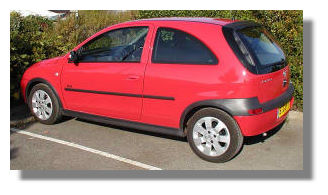 Despite concerns about financial credit squeezes and soaring fuel costs, Scottish motorists splashed out more than £2 billion on new cars last year - an increase of over 3% over the previous year. 200,803 new cars were driven off garage forecourts in 2007, up from 194,866 in 2006. Half of all the cars were sold in Glasgow and Strathclyde. December sales of new cars were up by 4.95%. The top-selling car was the compact Vauxhall Corsa, with 11,527 sales. That helped Vauxhall win the contest to be the best selling manufacturer, with 14.9% of the market.
Despite concerns about financial credit squeezes and soaring fuel costs, Scottish motorists splashed out more than £2 billion on new cars last year - an increase of over 3% over the previous year. 200,803 new cars were driven off garage forecourts in 2007, up from 194,866 in 2006. Half of all the cars were sold in Glasgow and Strathclyde. December sales of new cars were up by 4.95%. The top-selling car was the compact Vauxhall Corsa, with 11,527 sales. That helped Vauxhall win the contest to be the best selling manufacturer, with 14.9% of the market.
 A government survey has shown that the number of people smoking tobacco in Scotland has fallen from 45% in 1978 to 25% in 2006. Although that is a big improvement, and a decrease from 28% in 2005, Scotland still has a higher percentage of the population smoking than any other part of the UK. Smoking is now equally spread, with 25% of men and 25% of women considering themselves smokers, although women smoke fewer cigarettes a day (13 on average) than men (an average of 15 a day).
A government survey has shown that the number of people smoking tobacco in Scotland has fallen from 45% in 1978 to 25% in 2006. Although that is a big improvement, and a decrease from 28% in 2005, Scotland still has a higher percentage of the population smoking than any other part of the UK. Smoking is now equally spread, with 25% of men and 25% of women considering themselves smokers, although women smoke fewer cigarettes a day (13 on average) than men (an average of 15 a day). 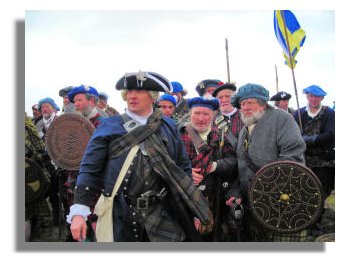 After lengthy delays and postponements, the new Culloden Battlefield centre has re-opened for visitors following an £8 million facelift. It should have been ready in April 2007 on the anniversary of the conflict in 1746. Designed to immerse visitors in the history of the confrontation between Bonnie Prince Charlie and his Highland army and the government forces, the new visitor centre was the largest construction project ever undertaken by the National Trust for Scotland. It features a special interactive exhibition following real life character through the years of the Jacobite rebellion. There is a 360 degree "total immersion" film which plunges visitors into the heart of the battle itself and it was the new technology which held back the opening, which only just made it as part of the Highland Year of Culture in 2007. An official opening will take place later in 2008.
After lengthy delays and postponements, the new Culloden Battlefield centre has re-opened for visitors following an £8 million facelift. It should have been ready in April 2007 on the anniversary of the conflict in 1746. Designed to immerse visitors in the history of the confrontation between Bonnie Prince Charlie and his Highland army and the government forces, the new visitor centre was the largest construction project ever undertaken by the National Trust for Scotland. It features a special interactive exhibition following real life character through the years of the Jacobite rebellion. There is a 360 degree "total immersion" film which plunges visitors into the heart of the battle itself and it was the new technology which held back the opening, which only just made it as part of the Highland Year of Culture in 2007. An official opening will take place later in 2008.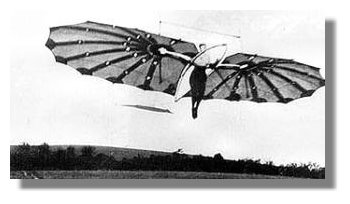 Percy Pilcher was a pioneer aviator who was inspired by Otto Lilienthal, the leading expert in gliding in Germany, to design, build and fly gliders in the hills above Cardross, north of the river Clyde. He became the first man to achieve controlled flight in a heavier-than-air craft, which he built during a break from his job as a lecturer at Glasgow University. That was in June 1895 and he went on to he break the world distance record when he flew 250 metres (820 feet). He built a powered triplane which he was going to demonstrate to sponsors and onlookers in September 1899. But the engine broke down, so he flew his glider instead so as not to disappoint his guests - but crashed and was killed. If he had succeeded with his powered aircraft, he would have done so four years before the Wright brothers. Now a ten-year project to reconstruct his first glider has been completed. The replica, made of Douglas Fir, cotton fabric, hemp twine and galvanised steel wire, and weighing just 50lbs, has been unveiled in a small aviation factory by the runway of Prestwick airport. The glider will be displayed in Glasgow's forthcoming Riverside Museum, due to be completed in 2010.
Percy Pilcher was a pioneer aviator who was inspired by Otto Lilienthal, the leading expert in gliding in Germany, to design, build and fly gliders in the hills above Cardross, north of the river Clyde. He became the first man to achieve controlled flight in a heavier-than-air craft, which he built during a break from his job as a lecturer at Glasgow University. That was in June 1895 and he went on to he break the world distance record when he flew 250 metres (820 feet). He built a powered triplane which he was going to demonstrate to sponsors and onlookers in September 1899. But the engine broke down, so he flew his glider instead so as not to disappoint his guests - but crashed and was killed. If he had succeeded with his powered aircraft, he would have done so four years before the Wright brothers. Now a ten-year project to reconstruct his first glider has been completed. The replica, made of Douglas Fir, cotton fabric, hemp twine and galvanised steel wire, and weighing just 50lbs, has been unveiled in a small aviation factory by the runway of Prestwick airport. The glider will be displayed in Glasgow's forthcoming Riverside Museum, due to be completed in 2010.
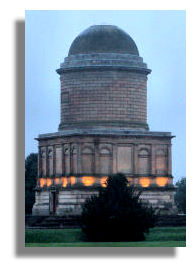 The Hamilton Mausoleum near Strathclyde Park in South Lanarkshire was begun in 1842 by the 10th Duke of Hamilton as a burial place for his family. It is a prominent landmark in the area and a popular tourist attraction - guarded by two lions, one sleeping, one awake. Now, after a major restoration involving re-roofing the building and restoration of the stonework, the local council has agreed a 99-year lease on the building to ensure that it can carry out maintenance work on the building in the future. The mausoleum sits in the Dalzell Estate in Hamilton, which is already owned by the council. In addition, Historic Scotland has agreed to give a grant of almost £90,000 for work on buildings in the wider estate.
The Hamilton Mausoleum near Strathclyde Park in South Lanarkshire was begun in 1842 by the 10th Duke of Hamilton as a burial place for his family. It is a prominent landmark in the area and a popular tourist attraction - guarded by two lions, one sleeping, one awake. Now, after a major restoration involving re-roofing the building and restoration of the stonework, the local council has agreed a 99-year lease on the building to ensure that it can carry out maintenance work on the building in the future. The mausoleum sits in the Dalzell Estate in Hamilton, which is already owned by the council. In addition, Historic Scotland has agreed to give a grant of almost £90,000 for work on buildings in the wider estate.
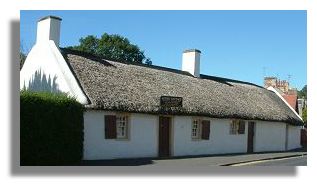 It's not as if the 250th anniversary of the birth of Robert Burns has crept up suddenly, but the National Trust for Scotland, which took over the museum beside the cottage where he was born, has warned that the much-needed refurbishment of the museum in Alloway, Ayrshire, will not be completed in time for the anniversary on 25 January 2009. Indeed it may not be completed until 2010. After the usual delays in obtaining financial support for the project from the previous Scottish Executive (£5.5 million) and from the National Lottery Fund (£5.8 million), funding for a new museum was formally announced a year ago. Even so, further finance still has to be organised. The intention had been to have everything ready for a grand opening in January 2009, kickstarting the much-vaunted Year of Homecoming, a Scottish Government-backed initiative to encourage foreign-based Scots back to the country.
It's not as if the 250th anniversary of the birth of Robert Burns has crept up suddenly, but the National Trust for Scotland, which took over the museum beside the cottage where he was born, has warned that the much-needed refurbishment of the museum in Alloway, Ayrshire, will not be completed in time for the anniversary on 25 January 2009. Indeed it may not be completed until 2010. After the usual delays in obtaining financial support for the project from the previous Scottish Executive (£5.5 million) and from the National Lottery Fund (£5.8 million), funding for a new museum was formally announced a year ago. Even so, further finance still has to be organised. The intention had been to have everything ready for a grand opening in January 2009, kickstarting the much-vaunted Year of Homecoming, a Scottish Government-backed initiative to encourage foreign-based Scots back to the country.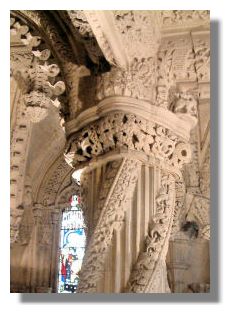 In 2007, the magnificent carvings within Rosslyn Chapel attracted 160,000 history to see the building which was created by Sir William St Clair in the 15th century. Many of those visiting the building (which had a starring role in the Da Vinci Code film) took their own pictures of the ornate carvings which cover pillars, walls and ceilings. But it seems that one or two of the photographers fell on uneven slabs in the dimly lit chapel while gazing at the screens on their cameras. So on health and safety grounds the trustees brought in a ban on photography from 2 January. That will be a great disappointment to the many who want their own mementos of their visit, especially as the outside of the building has been covered for many years in an ugly iron roof to help to dry out the stonework.
In 2007, the magnificent carvings within Rosslyn Chapel attracted 160,000 history to see the building which was created by Sir William St Clair in the 15th century. Many of those visiting the building (which had a starring role in the Da Vinci Code film) took their own pictures of the ornate carvings which cover pillars, walls and ceilings. But it seems that one or two of the photographers fell on uneven slabs in the dimly lit chapel while gazing at the screens on their cameras. So on health and safety grounds the trustees brought in a ban on photography from 2 January. That will be a great disappointment to the many who want their own mementos of their visit, especially as the outside of the building has been covered for many years in an ugly iron roof to help to dry out the stonework.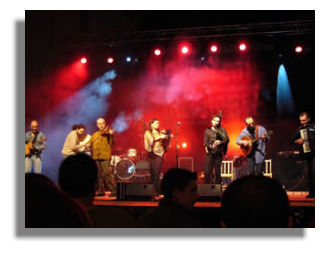 Celtic Connections, Scotland's largest winter music festival, began this week with a sell-out opening concert at Glasgow Royal Concert Hall. Several other shows in the popular roots, traditional and folk music festival have "house full" signs too. The event runs for two weeks and features over 1,000 artists. A second performance by singer songwriter Mindy Smith has been scheduled as her first gig at Òran Mór on January 26 sold out - the second performances will be at Òran Mór on January 31. Another highlight is the premiere of a Gaelic orchestral epic by the composer Ronald Stevenson - which took 40 years to write. The hour-long work "Ben Dorain" is based on an 18th-century poem by Duncan Ban MacIntyre.
Celtic Connections, Scotland's largest winter music festival, began this week with a sell-out opening concert at Glasgow Royal Concert Hall. Several other shows in the popular roots, traditional and folk music festival have "house full" signs too. The event runs for two weeks and features over 1,000 artists. A second performance by singer songwriter Mindy Smith has been scheduled as her first gig at Òran Mór on January 26 sold out - the second performances will be at Òran Mór on January 31. Another highlight is the premiere of a Gaelic orchestral epic by the composer Ronald Stevenson - which took 40 years to write. The hour-long work "Ben Dorain" is based on an 18th-century poem by Duncan Ban MacIntyre.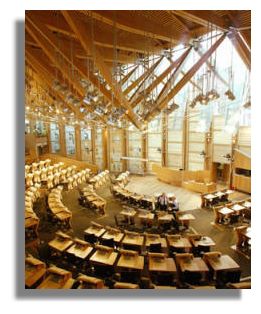 Many newspapers illustrated the successful approval of the first budget of the Scottish Nationalist Government this week with a photograph of First Minister Alex Salmond and his Finance Secretary John Swinney laughing uproariously. And well they might. The Nationalists are the largest party in the Scottish Parliament, but they are still a minority - with just 47 out of the 129 seats. So they should have struggled to get their budget allocations approved. But astute maneuvering by Alex Salmond (including a threat to call an election if his budget was not accepted), minor concessions to gain the support of two minority parties and disarray and ineptitude by the Labour Party, all contributed to it being allowed to sail through. The Scottish Nationalists had the surprising support of the Conservative Party - staunch supporters of the United Kingdom that the nationalists aim to dissolve. The Conservatives (with 16 Members of the Scottish Parliament) got a few crumbs of amendments in the budget - and the satisfaction of seeing their Labour Party rivals made to squirm. In the end, the Labour Party abstained from the final vote (odd for a party that had rejected it out of hand) and even found themselves abstaining on one of their own minor amendments when it was accepted by the Finance Secretary. The final vote was 64 votes in favour, one against and 60 abstentions. There was a suggestion afterwards that the one vote against (by a Labour MSP) was due to pressing the wrong button on the electronic voting system. If true, it was a fitting finish.
Many newspapers illustrated the successful approval of the first budget of the Scottish Nationalist Government this week with a photograph of First Minister Alex Salmond and his Finance Secretary John Swinney laughing uproariously. And well they might. The Nationalists are the largest party in the Scottish Parliament, but they are still a minority - with just 47 out of the 129 seats. So they should have struggled to get their budget allocations approved. But astute maneuvering by Alex Salmond (including a threat to call an election if his budget was not accepted), minor concessions to gain the support of two minority parties and disarray and ineptitude by the Labour Party, all contributed to it being allowed to sail through. The Scottish Nationalists had the surprising support of the Conservative Party - staunch supporters of the United Kingdom that the nationalists aim to dissolve. The Conservatives (with 16 Members of the Scottish Parliament) got a few crumbs of amendments in the budget - and the satisfaction of seeing their Labour Party rivals made to squirm. In the end, the Labour Party abstained from the final vote (odd for a party that had rejected it out of hand) and even found themselves abstaining on one of their own minor amendments when it was accepted by the Finance Secretary. The final vote was 64 votes in favour, one against and 60 abstentions. There was a suggestion afterwards that the one vote against (by a Labour MSP) was due to pressing the wrong button on the electronic voting system. If true, it was a fitting finish.

 There was more than usual interest in Scotland in the Super Bowl game last Sunday when the New York Giants played New England Patriots. For the first time ever, a Scottish born player was participating in the biggest event in America's sporting calendar - and he produced a flawless performance. Lawrence Tynes, Giants' 29-year-old kicker, opened the scoring with a 32-yard field goal and later got the two extra points after his team-mates scored two touchdowns. The New York Giants denied the Patriots what would have been a record-breaking run of 19 wins to win the Super Bowl 17-14. Tynes was born in Greenock in Scotland and moved to the US with his American father when he was 10. Earlier in his NFL career, Tynes returned to Scotland to play for the Scottish Claymores when they participated in the NFL's European League.
There was more than usual interest in Scotland in the Super Bowl game last Sunday when the New York Giants played New England Patriots. For the first time ever, a Scottish born player was participating in the biggest event in America's sporting calendar - and he produced a flawless performance. Lawrence Tynes, Giants' 29-year-old kicker, opened the scoring with a 32-yard field goal and later got the two extra points after his team-mates scored two touchdowns. The New York Giants denied the Patriots what would have been a record-breaking run of 19 wins to win the Super Bowl 17-14. Tynes was born in Greenock in Scotland and moved to the US with his American father when he was 10. Earlier in his NFL career, Tynes returned to Scotland to play for the Scottish Claymores when they participated in the NFL's European League.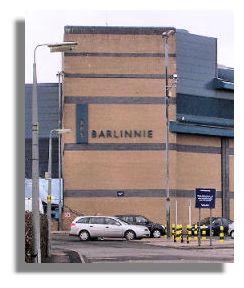 The latest figures on the number of people in Scotland's prisons show that there were a total of 7,609 in custody, an all-time high. That's around 1,000 above capacity and 20% higher than ten years ago. The Scottish government has indicated that it wants to see greater use made of community sentences as a way of reducing prison numbers and also aims to tackle Scotland's high re-offending rates.
The latest figures on the number of people in Scotland's prisons show that there were a total of 7,609 in custody, an all-time high. That's around 1,000 above capacity and 20% higher than ten years ago. The Scottish government has indicated that it wants to see greater use made of community sentences as a way of reducing prison numbers and also aims to tackle Scotland's high re-offending rates.
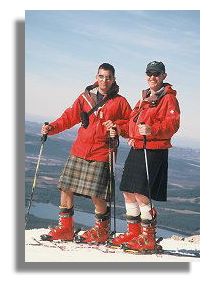 This year, ski resorts in the Scottish Highlands have enjoyed a better than average amount of snow, compared with recent winters. But a new study has shown that global warming and the reduced amount of snowfall has resulted in a five-fold decline in the number of skier days in Scotland in the space of just six years. Skiing is increasingly popular in the UK, with 1.3 million Britons taking to the slopes - an increase of 13% since 2003. But the with the number of Scottish skier days falling from 366,000 in the 2000-01 season to a mere 78,700 in 2006-07, most UK skiers are having to go to continental Europe ski slopes - often using low-cost flights to get there.
This year, ski resorts in the Scottish Highlands have enjoyed a better than average amount of snow, compared with recent winters. But a new study has shown that global warming and the reduced amount of snowfall has resulted in a five-fold decline in the number of skier days in Scotland in the space of just six years. Skiing is increasingly popular in the UK, with 1.3 million Britons taking to the slopes - an increase of 13% since 2003. But the with the number of Scottish skier days falling from 366,000 in the 2000-01 season to a mere 78,700 in 2006-07, most UK skiers are having to go to continental Europe ski slopes - often using low-cost flights to get there.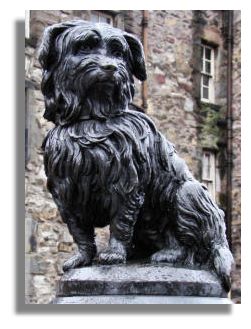 A new exhibition has opened to mark the 150th anniversary of the appearance of Edinburgh's most famous dog - Greyfriars Bobby. The Skye terrier was first seen in the church graveyard when its master, police constable John Gray, was buried on February 10, 1858. The exhibition, in the nearby Central Library on King George IV Bridge, has been organised by the One o'Clock Gun Association. There is an link between Greyfriars Bobby and the One o'Clock Gun which fires at Edinburgh Castle each day. When the gun fired, Bobby would trot out of the graveyard to be fed by a Colour Sergeant Donald McNab Scott, who was a clerk at the castle. The sergeant, who lived in nearby Candlemaker Row, also took Bobby for walks along King George IV Bridge - but the terrier always turned round at the end of the bridge and returned to the graveyard. Historic Scotland are in talks with the One o'Clock Gun Association to move the display to Edinburgh Castle later this year.
A new exhibition has opened to mark the 150th anniversary of the appearance of Edinburgh's most famous dog - Greyfriars Bobby. The Skye terrier was first seen in the church graveyard when its master, police constable John Gray, was buried on February 10, 1858. The exhibition, in the nearby Central Library on King George IV Bridge, has been organised by the One o'Clock Gun Association. There is an link between Greyfriars Bobby and the One o'Clock Gun which fires at Edinburgh Castle each day. When the gun fired, Bobby would trot out of the graveyard to be fed by a Colour Sergeant Donald McNab Scott, who was a clerk at the castle. The sergeant, who lived in nearby Candlemaker Row, also took Bobby for walks along King George IV Bridge - but the terrier always turned round at the end of the bridge and returned to the graveyard. Historic Scotland are in talks with the One o'Clock Gun Association to move the display to Edinburgh Castle later this year. Twins Craig and Charlie Reid, better known as the Proclaimers band that began in the 1980s, still attract a huge following. So a sell-out is expected for two outdoor concerts this summer when they perform at Edinburgh Castle esplanade and Bught Park in Inverness. The brothers performed at the Live 8 gig at Murrayfield stadium in the Scottish capital two years ago. They are best known for the songs "Letter from America", "I'm on My Way", and "I'm Gonna Be (500 Miles)".
Twins Craig and Charlie Reid, better known as the Proclaimers band that began in the 1980s, still attract a huge following. So a sell-out is expected for two outdoor concerts this summer when they perform at Edinburgh Castle esplanade and Bught Park in Inverness. The brothers performed at the Live 8 gig at Murrayfield stadium in the Scottish capital two years ago. They are best known for the songs "Letter from America", "I'm on My Way", and "I'm Gonna Be (500 Miles)". 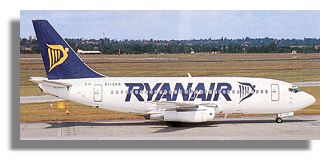 Budget airline Ryanair has announced that it is to introduce another twelve direct routes from Edinburgh airport to European destinations as part of expansion plans, with services to Berlin, Bratislava, Stockholm, and Polish destinations such as Poznan, Krakow, Lodz and Wroclaw. The extra routes are expected to attract more than 1.2 million passengers and will take the number of routes served by Ryanair from Edinburgh to 19 - last year it had only two. Edinburgh Airport now has more than 40 airlines serving more than 100 destinations, handling more than nine million passengers a year.
Budget airline Ryanair has announced that it is to introduce another twelve direct routes from Edinburgh airport to European destinations as part of expansion plans, with services to Berlin, Bratislava, Stockholm, and Polish destinations such as Poznan, Krakow, Lodz and Wroclaw. The extra routes are expected to attract more than 1.2 million passengers and will take the number of routes served by Ryanair from Edinburgh to 19 - last year it had only two. Edinburgh Airport now has more than 40 airlines serving more than 100 destinations, handling more than nine million passengers a year.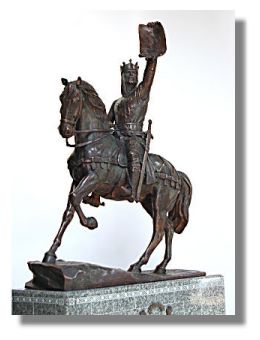 Last year, Aberdeen City Council decided that the Granite City should recognise the debt owed to King Robert the Bruce as a benefactor. Not before time, either... Aberdeen was one of the cities to shelter King Robert the Bruce when he was deposed by King Edward I's army in 1307. In return, when he returned to power, Robert the Bruce issued the Greater Charter in 1319 and granted Aberdeen the Forest of Stocket (now Mid Stocket) in feu. The money generated by the Forest has been used to create the Common Good Fund which has helped to build some of the city's great landmarks such as Marischal College, Aberdeen Art Gallery, the Central Library, Aberdeen Royal Infirmary and Hazlehead Park. A design competition for a statue was organised and the public were asked to vote on which of three submissions should be selected. Now the winning design by Alan B Herriot has been announced. It shows Robert the Bruce in defiant pose on a war horse, holding high the charter. Now the council has to decide where to locate the statue - Alan Herriot says he favours near the historic and impressive Marischal College. The three short listed designs can be seen at
Last year, Aberdeen City Council decided that the Granite City should recognise the debt owed to King Robert the Bruce as a benefactor. Not before time, either... Aberdeen was one of the cities to shelter King Robert the Bruce when he was deposed by King Edward I's army in 1307. In return, when he returned to power, Robert the Bruce issued the Greater Charter in 1319 and granted Aberdeen the Forest of Stocket (now Mid Stocket) in feu. The money generated by the Forest has been used to create the Common Good Fund which has helped to build some of the city's great landmarks such as Marischal College, Aberdeen Art Gallery, the Central Library, Aberdeen Royal Infirmary and Hazlehead Park. A design competition for a statue was organised and the public were asked to vote on which of three submissions should be selected. Now the winning design by Alan B Herriot has been announced. It shows Robert the Bruce in defiant pose on a war horse, holding high the charter. Now the council has to decide where to locate the statue - Alan Herriot says he favours near the historic and impressive Marischal College. The three short listed designs can be seen at 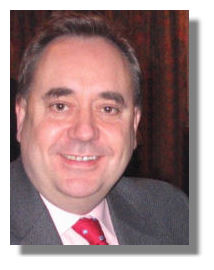 A recent opinion poll shows that First Minister Alex Salmond recorded a huge lead in the personal approval ratings over his Labour Party rival, Wendy Alexander. The Scottish Nationalist leader was given a plus 53% rating by voters - against minus 22% for the struggling Labour leader. On the opinion polls on voting if a Scottish parliamentary election were held this week, the Scottish National Party (SNP) polled 39% on the constituency ballot (up 6% from last May) and Labour recorded 31% (1% down from last year. On the basis of this poll, the SNP would increase their majority if a Scottish election were held tomorrow, winning 57 seats, while Labour would win 44. The Conservatives would win 16 seats and the Liberal Democrats 12.
A recent opinion poll shows that First Minister Alex Salmond recorded a huge lead in the personal approval ratings over his Labour Party rival, Wendy Alexander. The Scottish Nationalist leader was given a plus 53% rating by voters - against minus 22% for the struggling Labour leader. On the opinion polls on voting if a Scottish parliamentary election were held this week, the Scottish National Party (SNP) polled 39% on the constituency ballot (up 6% from last May) and Labour recorded 31% (1% down from last year. On the basis of this poll, the SNP would increase their majority if a Scottish election were held tomorrow, winning 57 seats, while Labour would win 44. The Conservatives would win 16 seats and the Liberal Democrats 12.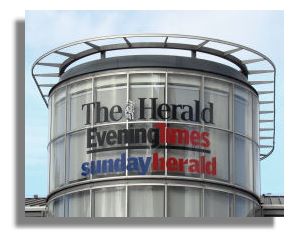 The Herald newspaper (which used to be known as the Glasgow Herald until it changed its name to emphasise it was a national rather than local paper) was first published in 1783. To mark the anniversary, it included in its edition last Saturday a special magazine that chronicled the paper's history. It covers not just the newspaper but the changing face of Glasgow and Scotland as well as looking to the future - and the challenge and opportunity of the Internet.
The Herald newspaper (which used to be known as the Glasgow Herald until it changed its name to emphasise it was a national rather than local paper) was first published in 1783. To mark the anniversary, it included in its edition last Saturday a special magazine that chronicled the paper's history. It covers not just the newspaper but the changing face of Glasgow and Scotland as well as looking to the future - and the challenge and opportunity of the Internet.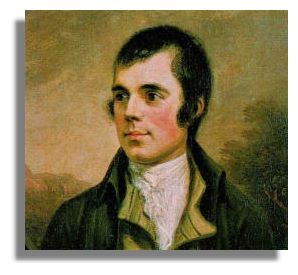 The original manuscript by Robert Burns for "Auld Lang Syne" is being taken to New York to be put on display as part of the Scotland Week 2008 celebrations (previously known as Tartan Week). It will be displayed at the Grolier Club and then on April 6 it will go on show for the day at the New York Public Library. Auld Lang Syne is known around the world and is the unofficial anthem of New Year celebrations. For all the words (with a version in plain English as well) see
The original manuscript by Robert Burns for "Auld Lang Syne" is being taken to New York to be put on display as part of the Scotland Week 2008 celebrations (previously known as Tartan Week). It will be displayed at the Grolier Club and then on April 6 it will go on show for the day at the New York Public Library. Auld Lang Syne is known around the world and is the unofficial anthem of New Year celebrations. For all the words (with a version in plain English as well) see 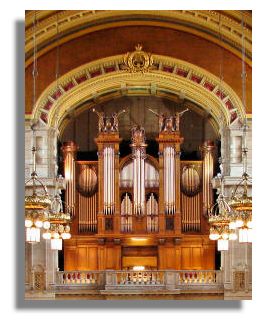 For the last year, there have been daily organ recitals at the Kelvingrove Art Gallery and Museum in Glasgow, featuring leading players from home and abroad. The Victorian main hall has been filled with the sonorous tones of the 100-year-old Lewis organ. each performance lasting for between 30 and 45 minutes. The recitals have been sponsored by a group of leading Glasgow businessmen who call themselves the "Golden Oldies" as they are all over 65. Now they are looking for more people to get involved to keep the tradition going, but anyone wanting to get involved must satisfy one rule - they must be at least 65 years young. This year the museum is installing two high-definition television screens showing the organists' hands and feet, so that those listening can also watch in more detail the demanding task of playing the instrument. The 3,000-pipe organ was built over 100 years ago for the 1901 International Exhibition in Kelvingrove Park. When it was installed in the museum, a walnut case front and non-functional display pipes were added.
For the last year, there have been daily organ recitals at the Kelvingrove Art Gallery and Museum in Glasgow, featuring leading players from home and abroad. The Victorian main hall has been filled with the sonorous tones of the 100-year-old Lewis organ. each performance lasting for between 30 and 45 minutes. The recitals have been sponsored by a group of leading Glasgow businessmen who call themselves the "Golden Oldies" as they are all over 65. Now they are looking for more people to get involved to keep the tradition going, but anyone wanting to get involved must satisfy one rule - they must be at least 65 years young. This year the museum is installing two high-definition television screens showing the organists' hands and feet, so that those listening can also watch in more detail the demanding task of playing the instrument. The 3,000-pipe organ was built over 100 years ago for the 1901 International Exhibition in Kelvingrove Park. When it was installed in the museum, a walnut case front and non-functional display pipes were added.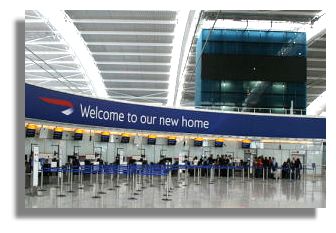 London Heathrow airport's new £4.3 billion Terminal 5 opened to the public at the end of March and immediately degenerated into chaos with large numbers of flights being cancelled, long delays and mountains of baggage missing flights. The terminal is dedicated to British Airways (BA) flights and as the airline struggled to cope, it was internal flights to Scotland that suffered most as BA tried to keep as many international travellers as possible moving. The problems continued for most of the week, with an estimated 20,000 items of luggage in warehouses waiting to be sent on to passengers.
London Heathrow airport's new £4.3 billion Terminal 5 opened to the public at the end of March and immediately degenerated into chaos with large numbers of flights being cancelled, long delays and mountains of baggage missing flights. The terminal is dedicated to British Airways (BA) flights and as the airline struggled to cope, it was internal flights to Scotland that suffered most as BA tried to keep as many international travellers as possible moving. The problems continued for most of the week, with an estimated 20,000 items of luggage in warehouses waiting to be sent on to passengers.
 So far, the support of the Scottish Government to Tartan Week has been concentrated largely in the USA, particularly in New York with the parade along Sixth Avenue and other events. The tourism agency VisitScotland has also hosted the first Scotland in Toronto Week to tap into the Scottish ancestry of many Canadians. Now Scottish Culture Minister Linda Fabiani has suggested that she is keen to strengthen links in the Antipodes, with a Scotland Week in Australia. The Scottish Government is trying to change the name of the event to "Scotland Week" to focus on the modern aspects of Scotland - and also halved the budget this year for the event in the US to around £400,000. So there are some mixed messages coming across.
So far, the support of the Scottish Government to Tartan Week has been concentrated largely in the USA, particularly in New York with the parade along Sixth Avenue and other events. The tourism agency VisitScotland has also hosted the first Scotland in Toronto Week to tap into the Scottish ancestry of many Canadians. Now Scottish Culture Minister Linda Fabiani has suggested that she is keen to strengthen links in the Antipodes, with a Scotland Week in Australia. The Scottish Government is trying to change the name of the event to "Scotland Week" to focus on the modern aspects of Scotland - and also halved the budget this year for the event in the US to around £400,000. So there are some mixed messages coming across.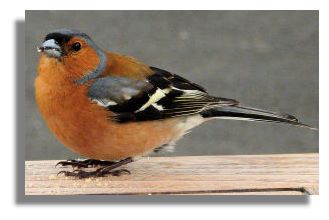 The Big Garden Bird Watch 2008, organised by the Royal Society for the Protection of Birds, shows that the chaffinch is the most commonly-sighted feathered friend in Scotland's gardens. Those taking part saw on average 5.43 chaffinches over an hour, when the survey was run in January. The second most common bird reported was the house sparrow, followed by the starling. Even though the total numbers were smaller, the blackbird was the most widely-seen bird, found in over 90% of gardens. But being territorial, blackies are rarely seen in any numbers in the one garden. For the first time the colourful siskin flew into the top ten - their numbers bolstered this year by Scandinavian immigrants. Overall, the survey suggested that fewer birds were seen compared with last year. Last summer's poor weather may have taken its toll of fledglings although milder winters also meant fewer birds came in this year from the countryside to feed in gardens as they had enough food in the wild.
The Big Garden Bird Watch 2008, organised by the Royal Society for the Protection of Birds, shows that the chaffinch is the most commonly-sighted feathered friend in Scotland's gardens. Those taking part saw on average 5.43 chaffinches over an hour, when the survey was run in January. The second most common bird reported was the house sparrow, followed by the starling. Even though the total numbers were smaller, the blackbird was the most widely-seen bird, found in over 90% of gardens. But being territorial, blackies are rarely seen in any numbers in the one garden. For the first time the colourful siskin flew into the top ten - their numbers bolstered this year by Scandinavian immigrants. Overall, the survey suggested that fewer birds were seen compared with last year. Last summer's poor weather may have taken its toll of fledglings although milder winters also meant fewer birds came in this year from the countryside to feed in gardens as they had enough food in the wild.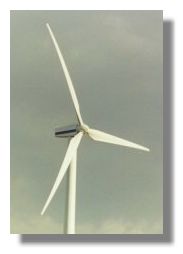 Wind turbines at Whitelee on Eaglesham Moor, south of Glasgow, have begun to supply power to the national grid. The first ten of an eventual 140 giant turbines stretching across 15 miles of skyline, began test runs after 18 months of site preparation - and five years of planning delays. Eventually, by next summer, when all the equipment is operational, the wind farm will produce 320 megawatts, said to be enough to power 180,000 homes and reduce carbon dioxide emissions by 650,000 tonnes a year, the equivalent to the output of 240,000 cars. The project has required the construction of 60 miles of roads to allow the 200 feet turbines to be transported across boggy moorland. The blades will rotate at 17 revolutions a minute and the foundations had to be dug to a depth of 30 feet until the construction teams hit hard ground beneath the peat. Critics of the scheme argue that the carbon emissions from the peat digging far outweigh those prevented, while the greater Glasgow area will be turned into "the world's biggest part-time power station". Once construction has been completed, the entire area will be opened to ramblers, bird watchers and mountain bikers, who will have spectacular views of central Scotland.
Wind turbines at Whitelee on Eaglesham Moor, south of Glasgow, have begun to supply power to the national grid. The first ten of an eventual 140 giant turbines stretching across 15 miles of skyline, began test runs after 18 months of site preparation - and five years of planning delays. Eventually, by next summer, when all the equipment is operational, the wind farm will produce 320 megawatts, said to be enough to power 180,000 homes and reduce carbon dioxide emissions by 650,000 tonnes a year, the equivalent to the output of 240,000 cars. The project has required the construction of 60 miles of roads to allow the 200 feet turbines to be transported across boggy moorland. The blades will rotate at 17 revolutions a minute and the foundations had to be dug to a depth of 30 feet until the construction teams hit hard ground beneath the peat. Critics of the scheme argue that the carbon emissions from the peat digging far outweigh those prevented, while the greater Glasgow area will be turned into "the world's biggest part-time power station". Once construction has been completed, the entire area will be opened to ramblers, bird watchers and mountain bikers, who will have spectacular views of central Scotland.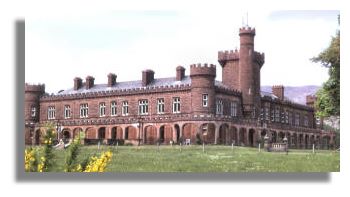 Plans by Prince Charles to restore Kinloch Castle on the Isle of Rum in the Inner Hebrides were dealt a blow this week when the Scottish Government declined to contribute £4.5 million of taxpayers' money to the project. Prince Charles has been "passionate" about saving Kinloch - which his great, great grandfather Edward VII used as a "pleasure palace". But the "green" scheme proposed by the Prince's Regeneration Trust to restore and develop the 111-year-old castle would have cost over £12 million - twice the original estimate, due to the inclusion of alternative energy systems such as photo-voltaic and solar panels in the roof and ground source heat pumps. Rum is inhabited by just 31 residents, but has 8,000 visitors a year. The island is owned by Scottish Natural Heritage, which is paying £70,000 a year just to maintain the castle.
Plans by Prince Charles to restore Kinloch Castle on the Isle of Rum in the Inner Hebrides were dealt a blow this week when the Scottish Government declined to contribute £4.5 million of taxpayers' money to the project. Prince Charles has been "passionate" about saving Kinloch - which his great, great grandfather Edward VII used as a "pleasure palace". But the "green" scheme proposed by the Prince's Regeneration Trust to restore and develop the 111-year-old castle would have cost over £12 million - twice the original estimate, due to the inclusion of alternative energy systems such as photo-voltaic and solar panels in the roof and ground source heat pumps. Rum is inhabited by just 31 residents, but has 8,000 visitors a year. The island is owned by Scottish Natural Heritage, which is paying £70,000 a year just to maintain the castle.
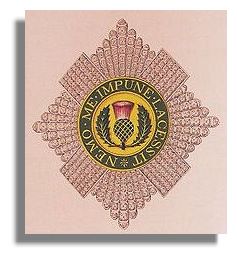 An exhibition on Scotland's highest order of chivalry is opening later this month in the Queen's Gallery at the Palace of Holyroodhouse in Edinburgh. The Most Ancient and Most Noble Order of the Thistle honours Scottish men and women who have held public office or who have contributed in a particular way to national life. At prestigious events for the order, the knights and ladies wear an elaborate costume which includes a green robe, a mantle tied with green and gold tassels and a hat made of black velvet. Its original date of foundation is unknown, James VII instituted the modern Order in 1687. There are only 16 members and all are required to be born in Scotland. The motto of the order is "Nemo me impune lacessit" (Latin for "No one provokes me with impunity" - or "Wha daur meddle wi me" in Scots). The same motto also appears on the Royal Coat of Arms of the United Kingdom for use in Scotland.
An exhibition on Scotland's highest order of chivalry is opening later this month in the Queen's Gallery at the Palace of Holyroodhouse in Edinburgh. The Most Ancient and Most Noble Order of the Thistle honours Scottish men and women who have held public office or who have contributed in a particular way to national life. At prestigious events for the order, the knights and ladies wear an elaborate costume which includes a green robe, a mantle tied with green and gold tassels and a hat made of black velvet. Its original date of foundation is unknown, James VII instituted the modern Order in 1687. There are only 16 members and all are required to be born in Scotland. The motto of the order is "Nemo me impune lacessit" (Latin for "No one provokes me with impunity" - or "Wha daur meddle wi me" in Scots). The same motto also appears on the Royal Coat of Arms of the United Kingdom for use in Scotland.
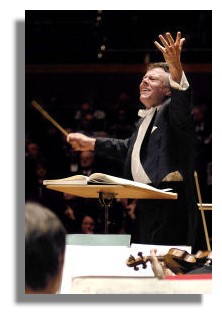 When the Edinburgh International Festival (EIF) began back in 1947, in the aftermath of the Second World war, Europe was a very different place from what it is today. So this year's EIF programme, the 62nd, which was announced this week, explores the challenges and changes facing modern Europe. It will include a host of world, European and UK premieres and many new productions of well-known works. There will be the world premiere of Matthew Bourne's Dorian Gray, a world premiere of a full stage production of Smetana's "The Two Widows" by Scottish Opera and performances from outstanding orchestras, including the Gothenburg Symphony Orchestra and the London Symphony Orchestra. The festival will culminate in Europe's largest annual firework display to live music, against the stunning backdrop of Edinburgh Castle.
When the Edinburgh International Festival (EIF) began back in 1947, in the aftermath of the Second World war, Europe was a very different place from what it is today. So this year's EIF programme, the 62nd, which was announced this week, explores the challenges and changes facing modern Europe. It will include a host of world, European and UK premieres and many new productions of well-known works. There will be the world premiere of Matthew Bourne's Dorian Gray, a world premiere of a full stage production of Smetana's "The Two Widows" by Scottish Opera and performances from outstanding orchestras, including the Gothenburg Symphony Orchestra and the London Symphony Orchestra. The festival will culminate in Europe's largest annual firework display to live music, against the stunning backdrop of Edinburgh Castle.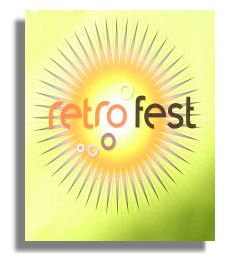 This year's two-day live music extravaganza Retrofest, aimed at lovers of music and culture from the 1960s to the 1990s, already has a line-up which includes Paul Young, Kim Wilde, The Bangles and Boy George. 70s legends Boney M and 10cc have also been booked. The annual festival on August 30 and 31 will include new events and stages for nostalgia lovers including a Retro Ritz Cinema, which will play all the top 80s movies and a Retro Rest Haven offering Duran Duran style "Re-Re-Reflexology" (whatever that is).
This year's two-day live music extravaganza Retrofest, aimed at lovers of music and culture from the 1960s to the 1990s, already has a line-up which includes Paul Young, Kim Wilde, The Bangles and Boy George. 70s legends Boney M and 10cc have also been booked. The annual festival on August 30 and 31 will include new events and stages for nostalgia lovers including a Retro Ritz Cinema, which will play all the top 80s movies and a Retro Rest Haven offering Duran Duran style "Re-Re-Reflexology" (whatever that is).
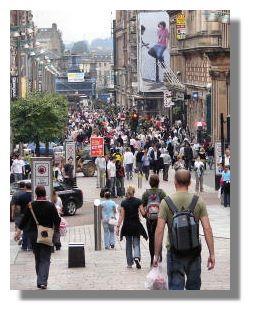 Scottish consumers are spending less in the face of the latest financial turbulence and expected economic slow-down. The latest figures from the Scottish Retail Consortium (SRC) show that like-for-like sales in March were just 1.6% higher than the same month in 2007, when they had risen 4.6% on the previous year. These figures were the worst since December and only the boost of Easter in March stopped non-food sales from falling, compared with a year ago. The slowdown in Scotland was less than in the UK as a whole, however, where like-for-like sales fell 1.6% below their March 2007 level. Clothing, footwear and homewares were particularly hard hit. Heavy rain and gales drove up sales of wintery soups and vegetables rather than salads and chilled products, while confectionery and gift foods benefited from Easter. The poor weather also dampened enthusiasm for shopping, though computer games software and hardware continued to do well, however, while flat-panel TV's and laptops remained popular.
Scottish consumers are spending less in the face of the latest financial turbulence and expected economic slow-down. The latest figures from the Scottish Retail Consortium (SRC) show that like-for-like sales in March were just 1.6% higher than the same month in 2007, when they had risen 4.6% on the previous year. These figures were the worst since December and only the boost of Easter in March stopped non-food sales from falling, compared with a year ago. The slowdown in Scotland was less than in the UK as a whole, however, where like-for-like sales fell 1.6% below their March 2007 level. Clothing, footwear and homewares were particularly hard hit. Heavy rain and gales drove up sales of wintery soups and vegetables rather than salads and chilled products, while confectionery and gift foods benefited from Easter. The poor weather also dampened enthusiasm for shopping, though computer games software and hardware continued to do well, however, while flat-panel TV's and laptops remained popular. 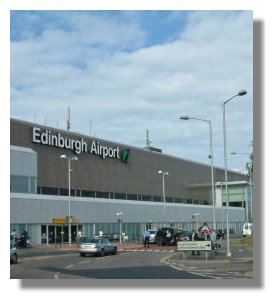 A report by the UK's Competition Commission has questioned the ownership of seven of the UK's largest airports by one company and has suggested that BAA (British Airports Authority, owned by a Spanish holding company) may be required to sell one or more of its airports. The commission suggests that "there is potential for competition between Edinburgh and Glasgow airports, hence common ownership adversely affects competition between them." The report does acknowledge that there is some limited competition from one non-BAA airport (Prestwick).
A report by the UK's Competition Commission has questioned the ownership of seven of the UK's largest airports by one company and has suggested that BAA (British Airports Authority, owned by a Spanish holding company) may be required to sell one or more of its airports. The commission suggests that "there is potential for competition between Edinburgh and Glasgow airports, hence common ownership adversely affects competition between them." The report does acknowledge that there is some limited competition from one non-BAA airport (Prestwick). 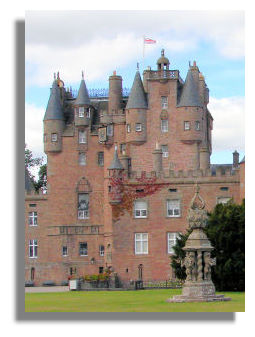 Prince Charles has unveiled a set of new gates at Glamis castle which have been built in memory of his grandmother, the late Queen Mother. Glamis has royal links going back to 1372 and the castle was the her childhood home when she was Elizabeth Bowes-Lyon, daughter of the Earl of Strathmore and Kinghorne. Donations from home and abroad contributed to the cost of the new gates, which were built and designed locally. The gates are at a new entrance which reinstates the original avenue between the castle and the village and helps the flow of the growing number of visitors to Glamis Castle and the surrounding gardens and estate.
Prince Charles has unveiled a set of new gates at Glamis castle which have been built in memory of his grandmother, the late Queen Mother. Glamis has royal links going back to 1372 and the castle was the her childhood home when she was Elizabeth Bowes-Lyon, daughter of the Earl of Strathmore and Kinghorne. Donations from home and abroad contributed to the cost of the new gates, which were built and designed locally. The gates are at a new entrance which reinstates the original avenue between the castle and the village and helps the flow of the growing number of visitors to Glamis Castle and the surrounding gardens and estate. 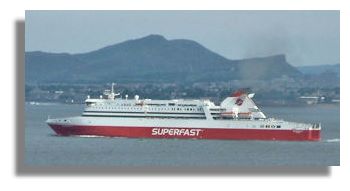 The Greece-based company which runs the daily Superfast Ferries from Rosyth in Fife to Zeebrugge in Belgium has announced that the service will stop operating in mid-September. The service was launched in 2002, saving passengers and truckers having to drive via Hull or the English Channel ports. The crossing to the Belgian port takes about 18 hours and each ferry can carry more than 1,000 passengers, 120 cars and 100 commercial vehicles. Over the years, there have been reports of the company struggling to make a profit on the route. While passenger numbers have been good, it struggled to attract the more profitable commercial vehicles in the early years. The Scottish Transport Minister said the decision was "very disappointing" and undertook to pursue all viable options to achieve continuity of the service. The ferry link is an important part of Scotland's access to European markets and now carries a significant percentage of freight to and from the continent.
The Greece-based company which runs the daily Superfast Ferries from Rosyth in Fife to Zeebrugge in Belgium has announced that the service will stop operating in mid-September. The service was launched in 2002, saving passengers and truckers having to drive via Hull or the English Channel ports. The crossing to the Belgian port takes about 18 hours and each ferry can carry more than 1,000 passengers, 120 cars and 100 commercial vehicles. Over the years, there have been reports of the company struggling to make a profit on the route. While passenger numbers have been good, it struggled to attract the more profitable commercial vehicles in the early years. The Scottish Transport Minister said the decision was "very disappointing" and undertook to pursue all viable options to achieve continuity of the service. The ferry link is an important part of Scotland's access to European markets and now carries a significant percentage of freight to and from the continent.
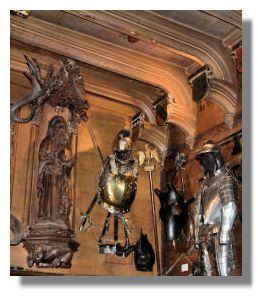 A £10 million campaign has been launched to ensure the future of Abbotsford, the historic home of novelist Sir Walter Scott near Melrose in the Scottish Borders. He lived there from 1824 until his death in 1832 and the building is packed with items he collected during his lifetime. The future of the property has been uncertain following the death in 2004 of Dame Jean Maxwell-Scott, his last direct descendant to live in the property. The Abbotsford Trust will now seek finance from the Heritage Lottery Fund and the aim is to raise matched funding from other organisations and individuals around the world. It has been suggested that to attract more visitors, the railway station at the end of the planned Waverley line between Edinburgh and the Borders should be "Abbotsford" instead of the present plan for "Tweedbank". The station will be less than half a mile away from Abbotsford. Abbotsford currently only attracts 30,000 visitors a year.
A £10 million campaign has been launched to ensure the future of Abbotsford, the historic home of novelist Sir Walter Scott near Melrose in the Scottish Borders. He lived there from 1824 until his death in 1832 and the building is packed with items he collected during his lifetime. The future of the property has been uncertain following the death in 2004 of Dame Jean Maxwell-Scott, his last direct descendant to live in the property. The Abbotsford Trust will now seek finance from the Heritage Lottery Fund and the aim is to raise matched funding from other organisations and individuals around the world. It has been suggested that to attract more visitors, the railway station at the end of the planned Waverley line between Edinburgh and the Borders should be "Abbotsford" instead of the present plan for "Tweedbank". The station will be less than half a mile away from Abbotsford. Abbotsford currently only attracts 30,000 visitors a year.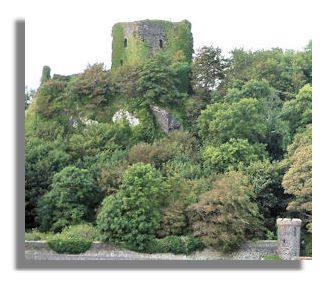 The MacDougall of Dunollie Preservation Trust has announced plans to make the ruinous Dunollie Castle in Oban safe for the public and the neighbouring historic house open to visitors. The trust has received an initial project planning grant from the Heritage Lottery Fund and hope to apply for a larger grant later this year. If this is successful, Dunollie House could open as a museum and clan centre by 2010. The aim is to create a house full of interesting objects telling the stories of the family and of life in the big house. The trust has archives which go back to the Jacobite rebellion in 1715. The MacDougalls have been at Dunollie since around 1130.
The MacDougall of Dunollie Preservation Trust has announced plans to make the ruinous Dunollie Castle in Oban safe for the public and the neighbouring historic house open to visitors. The trust has received an initial project planning grant from the Heritage Lottery Fund and hope to apply for a larger grant later this year. If this is successful, Dunollie House could open as a museum and clan centre by 2010. The aim is to create a house full of interesting objects telling the stories of the family and of life in the big house. The trust has archives which go back to the Jacobite rebellion in 1715. The MacDougalls have been at Dunollie since around 1130.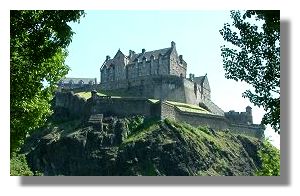 Figures published by the tourism agency VisitScotland show that the number of visitors to Scotland's tourist attractions grew by 1.7% last year, reaching 45.7 million. The most popular paid-for attraction was once again Edinburgh Castle (with 1,200,000), with Glasgow's Kelvingrove Art Gallery and Museum heading the table of free attractions, with 2.2 million visitors. Glasgow Science Centre did well, with an increase in visitor numbers of 17% but the Scottish Sea Bird Centre in North Berwick had the biggest rise in visitors, with 26% more than the year before, rising from 225,500 customers to 284,702. There were also increased visitor numbers at the Falkirk Wheel, St Giles Cathedral in Edinburgh and the Shetland Museum and Archive. But the People's Palace museum in Glasgow saw its numbers dip by 18.4% - the largest decrease in the country. The VisitScotland figures show that English tourists account for the highest proportion of visitors to Scotland's attractions - despite the attractions being on our doorstep.
Figures published by the tourism agency VisitScotland show that the number of visitors to Scotland's tourist attractions grew by 1.7% last year, reaching 45.7 million. The most popular paid-for attraction was once again Edinburgh Castle (with 1,200,000), with Glasgow's Kelvingrove Art Gallery and Museum heading the table of free attractions, with 2.2 million visitors. Glasgow Science Centre did well, with an increase in visitor numbers of 17% but the Scottish Sea Bird Centre in North Berwick had the biggest rise in visitors, with 26% more than the year before, rising from 225,500 customers to 284,702. There were also increased visitor numbers at the Falkirk Wheel, St Giles Cathedral in Edinburgh and the Shetland Museum and Archive. But the People's Palace museum in Glasgow saw its numbers dip by 18.4% - the largest decrease in the country. The VisitScotland figures show that English tourists account for the highest proportion of visitors to Scotland's attractions - despite the attractions being on our doorstep. The Scottish musical play that tells the fascinating story of Nancy Mclehose and Robert Burns toured Scotland earlier this year. The platonic affair gave rise to the Clarinda and Sylvander exchange of letters and inspired Burns to write "Ae Fond Kiss". The musical included 16 songs written by Kevin Walsh and Mike Gibb - as well as Burns' own beautiful love song. Now a cast album of the production has been created which includes all those songs from the show. Plans are also well in hand for a production of "Clarinda" at larger Scottish venues plus a visit to London in addition to appearances at a number of Homecoming 2009 events. For more details on the show and the album, see
The Scottish musical play that tells the fascinating story of Nancy Mclehose and Robert Burns toured Scotland earlier this year. The platonic affair gave rise to the Clarinda and Sylvander exchange of letters and inspired Burns to write "Ae Fond Kiss". The musical included 16 songs written by Kevin Walsh and Mike Gibb - as well as Burns' own beautiful love song. Now a cast album of the production has been created which includes all those songs from the show. Plans are also well in hand for a production of "Clarinda" at larger Scottish venues plus a visit to London in addition to appearances at a number of Homecoming 2009 events. For more details on the show and the album, see  This year, Glasgow's West End Festival runs from Friday the 13th until Sunday the 29th of June, with its usual conglomeration of art, music and theatre events. This is Glasgow’s largest cultural event, attracting over 110,000 people to free events and 39,000 to ticketed events last year. This year the West End Festival continues to expand the variety of its programme, adding new venues, exhibitions, theatre productions, concerts, fairs, events and walks to a list of events which reflects Glasgow’s enthusiasm for all facets of culture and entertainment. For more information, see
This year, Glasgow's West End Festival runs from Friday the 13th until Sunday the 29th of June, with its usual conglomeration of art, music and theatre events. This is Glasgow’s largest cultural event, attracting over 110,000 people to free events and 39,000 to ticketed events last year. This year the West End Festival continues to expand the variety of its programme, adding new venues, exhibitions, theatre productions, concerts, fairs, events and walks to a list of events which reflects Glasgow’s enthusiasm for all facets of culture and entertainment. For more information, see 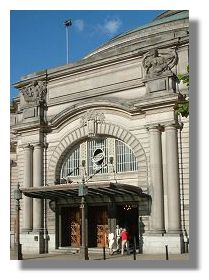 Edinburgh's Usher Hall applied for planning permission in June 2003 for a major refurbishment, including additional public space, a glass-fronted extension at the front, a new bar, new lifts, box office and offices above, and disabled access. It has been out of action since last year's Edinburgh Festival in August and will remain closed for six months longer than expected because of problems uncovered as the £20 million project developed. It will now not reopen until spring 2009 - apart from a brief spell during this summer's arts festival. As a result, the Royal Scottish National Orchestra will have to use the Edinburgh Festival Theatre for the 2008/09 season and will only perform 10 concerts instead of 20. The Scottish Chamber Orchestra is also having to relocate, this time to the Queen's Hall. The orchestras are negotiating financial compensation for loss of revenue and that is though to be around £350,000 - placing another strain on the total cost of the project.
Edinburgh's Usher Hall applied for planning permission in June 2003 for a major refurbishment, including additional public space, a glass-fronted extension at the front, a new bar, new lifts, box office and offices above, and disabled access. It has been out of action since last year's Edinburgh Festival in August and will remain closed for six months longer than expected because of problems uncovered as the £20 million project developed. It will now not reopen until spring 2009 - apart from a brief spell during this summer's arts festival. As a result, the Royal Scottish National Orchestra will have to use the Edinburgh Festival Theatre for the 2008/09 season and will only perform 10 concerts instead of 20. The Scottish Chamber Orchestra is also having to relocate, this time to the Queen's Hall. The orchestras are negotiating financial compensation for loss of revenue and that is though to be around £350,000 - placing another strain on the total cost of the project. On the 140th anniversary of the birth of Glasgow artist and architect Charles Rennie Mackintosh on 7 June, the Google search engine replaced its normal logo on its UK search engine with one inspired by his Art Nouveau designs. The logo was placed on-line for 24 hours and is estimated to have been seen by over 20 million people. Previously, in May 2006, Edinburgh-born Sir Arthur Conan Doyle's birthday was remembered by Google with a Sherlock Holmes design. Google has introduced other UK-specific logo changes for Guy Fawkes Day, a special daffodil version for Wales' St David's Day and a dragon and knight for St George's Day. There has never been one for St Andrew's Day, but Edinburgh Castle was featured in a "Five Wonders of Britain" Google logo in 2006.
On the 140th anniversary of the birth of Glasgow artist and architect Charles Rennie Mackintosh on 7 June, the Google search engine replaced its normal logo on its UK search engine with one inspired by his Art Nouveau designs. The logo was placed on-line for 24 hours and is estimated to have been seen by over 20 million people. Previously, in May 2006, Edinburgh-born Sir Arthur Conan Doyle's birthday was remembered by Google with a Sherlock Holmes design. Google has introduced other UK-specific logo changes for Guy Fawkes Day, a special daffodil version for Wales' St David's Day and a dragon and knight for St George's Day. There has never been one for St Andrew's Day, but Edinburgh Castle was featured in a "Five Wonders of Britain" Google logo in 2006.
 First Minister Alex Salmond this week unveiled the nationwide programme for "Homecoming 2009" which will include over 100 events to celebrate Scotland's first ever year of Homecoming. Inspired by the 250th anniversary of the birth of Scotland's national bard, Robert Burns, Homecoming 2009 will be a celebration of the great contributions Scotland has made to the world. It's also a chance for Scots around the globe to reconnect and engage with their heritage. The programme of events has been organised around five main themes - the Bard himself, Whisky, Golf, Great Scottish Minds and Innovations and Scotland's culture and heritage. Highlights include a Burns 250th anniversary weekend, including a campaign to create the world's biggest "virtual Burns Supper" celebration. There is also an exhibition of contemporary art inspired by Burns, to be held in Glasgow's Mitchell Library, featuring works by John Byrne, Tracy Emin, Graham Fagen and David Mach. A celebration of the Caledonian Canal will involve a flotilla travelling the length of the canal from Fort William to Inverness. During the year, The Open Golf Championship will return to Turnberry - and one of the largest clan gatherings in history will be held in Edinburgh. Although home-grown events predominate, Forbes Magazine has announced plans to return to Scotland for the first time in nearly 100 years to host their annual European CEO Forum, an influential business conference. See also
First Minister Alex Salmond this week unveiled the nationwide programme for "Homecoming 2009" which will include over 100 events to celebrate Scotland's first ever year of Homecoming. Inspired by the 250th anniversary of the birth of Scotland's national bard, Robert Burns, Homecoming 2009 will be a celebration of the great contributions Scotland has made to the world. It's also a chance for Scots around the globe to reconnect and engage with their heritage. The programme of events has been organised around five main themes - the Bard himself, Whisky, Golf, Great Scottish Minds and Innovations and Scotland's culture and heritage. Highlights include a Burns 250th anniversary weekend, including a campaign to create the world's biggest "virtual Burns Supper" celebration. There is also an exhibition of contemporary art inspired by Burns, to be held in Glasgow's Mitchell Library, featuring works by John Byrne, Tracy Emin, Graham Fagen and David Mach. A celebration of the Caledonian Canal will involve a flotilla travelling the length of the canal from Fort William to Inverness. During the year, The Open Golf Championship will return to Turnberry - and one of the largest clan gatherings in history will be held in Edinburgh. Although home-grown events predominate, Forbes Magazine has announced plans to return to Scotland for the first time in nearly 100 years to host their annual European CEO Forum, an influential business conference. See also  The Times Good University Guide, which is published each year, is not only perused by prospective students but by the universities themselves to see how they have fared in the league table of higher education establishments throughout the UK. As before, the top rated Scottish university is St Andrews, which once again lies 5th in the UK. Edinburgh comes next, ranked 18th (but down 5 places from last year). Glasgow University jumped up the rankings, however, from 31st to 20th in the table - only slightly below Edinburgh. The 113 UK universities are ranked according to eight criteria which include research quality and degree results as well as student satisfaction.
The Times Good University Guide, which is published each year, is not only perused by prospective students but by the universities themselves to see how they have fared in the league table of higher education establishments throughout the UK. As before, the top rated Scottish university is St Andrews, which once again lies 5th in the UK. Edinburgh comes next, ranked 18th (but down 5 places from last year). Glasgow University jumped up the rankings, however, from 31st to 20th in the table - only slightly below Edinburgh. The 113 UK universities are ranked according to eight criteria which include research quality and degree results as well as student satisfaction. 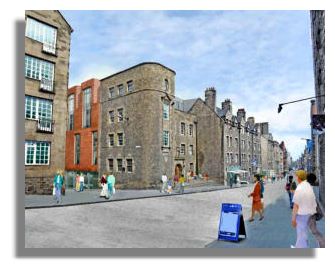 The controversial plans to redevelop part of Edinburgh's historic High Street at Canongate have already been approved by the city council. Now the Scottish government ministers - who had the final decision - have decided not to "call in" the proposals. That means there will not be a public enquiry and the city council is free to issue planning permission. The complex includes a 5-star luxury hotel and conference centre, an office complex and 200 homes. Some buildings on Canongate will be retained at the insistence of the planning authorities and the overall height of a passageway that goes through those buildings will be reduced and finished in natural stone. The £300 million project will transform that part of Edinburgh's Old Town. 15 years ago a bus depot in the area was demolished but hopes of developing the area have come and gone in the meantime. Now, work will start before the end of this year, with elements of the scheme completed by 2011, with a final completion date of 2013.
The controversial plans to redevelop part of Edinburgh's historic High Street at Canongate have already been approved by the city council. Now the Scottish government ministers - who had the final decision - have decided not to "call in" the proposals. That means there will not be a public enquiry and the city council is free to issue planning permission. The complex includes a 5-star luxury hotel and conference centre, an office complex and 200 homes. Some buildings on Canongate will be retained at the insistence of the planning authorities and the overall height of a passageway that goes through those buildings will be reduced and finished in natural stone. The £300 million project will transform that part of Edinburgh's Old Town. 15 years ago a bus depot in the area was demolished but hopes of developing the area have come and gone in the meantime. Now, work will start before the end of this year, with elements of the scheme completed by 2011, with a final completion date of 2013. 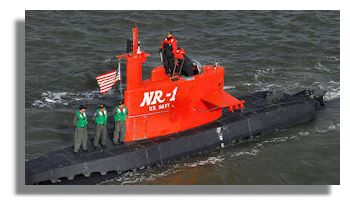 The nuclear submarine NR 1 is joining the hunt for the 18th century "Bonhomme Richard" which was captained by Scottish-born sailor John Paul Jones. The Scots captain - regarded as the founder of the US navy - was raiding the coast of Britain as part of the American War of Independence. In 1779, sailing as part of an American fleet (but advised by the French), he sailed up the coast of Scotland and on the return journey, threatened to open fire on the port of Leith. He was then met by a group of British ships off Flamborough Head. During the engagement (described as "one of the most desperate and sanguinary in naval history) he shouted his celebrated battle-cry: "I have not yet begun to fight!". The "Bonhomme Richard" and the British "Seraphis" both sank - but only after the latter had surrendered to Jones. Attempts are being made to find the wreck of his ship and the nuclear sub is well suited to such a task. It was used to recover parts of the Space Shuttle Challenger in 1986 and also played a part in studying the wreckage of the Titanic's sister ship, the Britannic, off the coast of Greece. The US team hopes to find evidence which can conclusively prove that it has discovered the elusive vessel which formed part of the fledgling US Navy.
The nuclear submarine NR 1 is joining the hunt for the 18th century "Bonhomme Richard" which was captained by Scottish-born sailor John Paul Jones. The Scots captain - regarded as the founder of the US navy - was raiding the coast of Britain as part of the American War of Independence. In 1779, sailing as part of an American fleet (but advised by the French), he sailed up the coast of Scotland and on the return journey, threatened to open fire on the port of Leith. He was then met by a group of British ships off Flamborough Head. During the engagement (described as "one of the most desperate and sanguinary in naval history) he shouted his celebrated battle-cry: "I have not yet begun to fight!". The "Bonhomme Richard" and the British "Seraphis" both sank - but only after the latter had surrendered to Jones. Attempts are being made to find the wreck of his ship and the nuclear sub is well suited to such a task. It was used to recover parts of the Space Shuttle Challenger in 1986 and also played a part in studying the wreckage of the Titanic's sister ship, the Britannic, off the coast of Greece. The US team hopes to find evidence which can conclusively prove that it has discovered the elusive vessel which formed part of the fledgling US Navy.
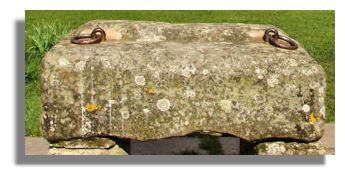 First Minister Alex Salmond has voiced his support for the theory that the stone which was surrendered to King Edward I in 1296 was not the real Stone of Destiny (used at the coronations of Scottish monarchs since the 9th century). Instead Edward took off to Westminster Abbey a fake and Scotland's iconic symbol was kept in Scotland - location unknown. The First Minister has reignited the debate by supporting the view that the Abbot of Scone (where the stone was located at that time) had passed off a forgery. The stone was placed under the throne in London - and English and then United Kingdom monarchs have been crowned since then while sitting above it. The First Minister rejected the idea of seeing if science could resolve the issue, saying it would be better to leave the mystery unsolved. One thing is sure, the Stone of Destiny currently displayed at Scone (seen here) is a replica!
First Minister Alex Salmond has voiced his support for the theory that the stone which was surrendered to King Edward I in 1296 was not the real Stone of Destiny (used at the coronations of Scottish monarchs since the 9th century). Instead Edward took off to Westminster Abbey a fake and Scotland's iconic symbol was kept in Scotland - location unknown. The First Minister has reignited the debate by supporting the view that the Abbot of Scone (where the stone was located at that time) had passed off a forgery. The stone was placed under the throne in London - and English and then United Kingdom monarchs have been crowned since then while sitting above it. The First Minister rejected the idea of seeing if science could resolve the issue, saying it would be better to leave the mystery unsolved. One thing is sure, the Stone of Destiny currently displayed at Scone (seen here) is a replica!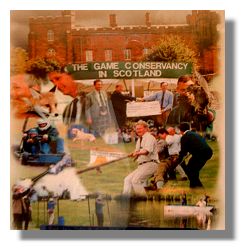 The Scottish Game Fair held in the grounds of Scone Palace from July 4 to 6 is set to hear the sounds of battle as the 1st Battalion 42nd Highland Regiment of Foot 1815 (The Black Watch) re-enactment group gives demonstrations of musketry and drill, as well as living authentically on site for the duration of the event. The group recreates The Black Watch regiment as it would have looked at the time of the Battle of Waterloo in 1815. Other attractions at the fair feature live game birds, fishing, clay shooting, gundogs and terriers. It is anticipated that a record number of visitors will be attracted by these displays and over 300 trade stands.
The Scottish Game Fair held in the grounds of Scone Palace from July 4 to 6 is set to hear the sounds of battle as the 1st Battalion 42nd Highland Regiment of Foot 1815 (The Black Watch) re-enactment group gives demonstrations of musketry and drill, as well as living authentically on site for the duration of the event. The group recreates The Black Watch regiment as it would have looked at the time of the Battle of Waterloo in 1815. Other attractions at the fair feature live game birds, fishing, clay shooting, gundogs and terriers. It is anticipated that a record number of visitors will be attracted by these displays and over 300 trade stands.
 A survey of cinema-goers asked to name their favourite Scottish film of all time put Mel Gibson's 1995 production "Braveheart" into top spot (of course). The black comedy "Trainspotting" was in second place. Perhaps surprisingly, as the respondents would include many of the younger cinema-goers, it was the 1940 black and white comedy "Whisky Galore" (known as "Tight Little Island" in the US) which came in third. Other films in the top ten were the sentimental story of Greyfriars Bobby and "Mrs Brown" which covered the relationship between Queen Victoria and her Highland servant John Brown. "Gregory's Girl" about an awkward schoolboy and his relationship with a football-playing girl was 7th.
A survey of cinema-goers asked to name their favourite Scottish film of all time put Mel Gibson's 1995 production "Braveheart" into top spot (of course). The black comedy "Trainspotting" was in second place. Perhaps surprisingly, as the respondents would include many of the younger cinema-goers, it was the 1940 black and white comedy "Whisky Galore" (known as "Tight Little Island" in the US) which came in third. Other films in the top ten were the sentimental story of Greyfriars Bobby and "Mrs Brown" which covered the relationship between Queen Victoria and her Highland servant John Brown. "Gregory's Girl" about an awkward schoolboy and his relationship with a football-playing girl was 7th.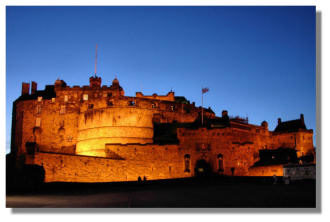 From time to time, Edinburgh City Council has been critical of the way in which VisitScotland, the country's tourism agency, has promoted the Capital. That opinion is often shared by Glasgow and other parts of the country who feel that "their" area is not getting enough attention. But now Edinburgh has cut £125,000 from its £625,000 annual grant to the agency, saying that it wants to increase its own promotion of the city as a tourist destination. VisitScotland is unhappy about this, of course, and is reported to have questioned the city council's "candour and professionalism". But the City Council has responded by saying that the tourism agency has failed to provide any evidence of the economic benefit that its work has brought the Capital. The council wants a more focused Edinburgh marketing strategy focusing on its unique attributes, instead of the wider national tourism campaigns which are often a feature of VisitScotland.
From time to time, Edinburgh City Council has been critical of the way in which VisitScotland, the country's tourism agency, has promoted the Capital. That opinion is often shared by Glasgow and other parts of the country who feel that "their" area is not getting enough attention. But now Edinburgh has cut £125,000 from its £625,000 annual grant to the agency, saying that it wants to increase its own promotion of the city as a tourist destination. VisitScotland is unhappy about this, of course, and is reported to have questioned the city council's "candour and professionalism". But the City Council has responded by saying that the tourism agency has failed to provide any evidence of the economic benefit that its work has brought the Capital. The council wants a more focused Edinburgh marketing strategy focusing on its unique attributes, instead of the wider national tourism campaigns which are often a feature of VisitScotland. 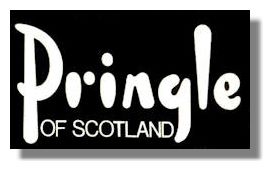 One of Scotland's iconic knitwear brands is likely to close its factory in Hawick, with the loss of 80 jobs. Instead, Pringle of Scotland will move its production to Italy. The company was taken over by Fang Brothers in 200 and they have invested £45 million in the brand, which has increased sales as a result. But last year the textile company lost £9 million and blamed the "changing nature" of the competitive market. Manufacturing costs in Italy would be 30% lower than in Scotland but the company's history in the Borders dates back to 1815. There were calls for the company to stop using the "Pringle of Scotland" marketing and change it to "Pringle of Italy". But the company's HQ and office staff will still be located in Hawick.
One of Scotland's iconic knitwear brands is likely to close its factory in Hawick, with the loss of 80 jobs. Instead, Pringle of Scotland will move its production to Italy. The company was taken over by Fang Brothers in 200 and they have invested £45 million in the brand, which has increased sales as a result. But last year the textile company lost £9 million and blamed the "changing nature" of the competitive market. Manufacturing costs in Italy would be 30% lower than in Scotland but the company's history in the Borders dates back to 1815. There were calls for the company to stop using the "Pringle of Scotland" marketing and change it to "Pringle of Italy". But the company's HQ and office staff will still be located in Hawick.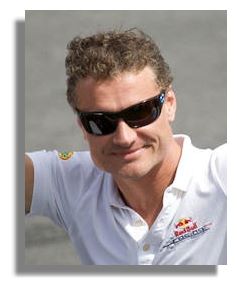 David Coulthard from Twynholm in Dumfries and Galloway has been racing for 25 years (he won the Scottish Junior Kart Championship in 1983) and at 37 he is now the oldest driver in Formula 1 motor racing. Now he has announced that he will retire at the end of this season. During his career in F1 racing, he has had 13 victories. He failed to become world F1 driving champion, in part due to his career being eclipsed by the dominance of Michael Schumacher. In 2001, Coulthard finished second to the German in the drivers' championship. The year before he had walked away from a plane crash in which the two pilots died. That event made him "refocus" his life. Now he is looking forward to continuing in motor racing - probably at the track side or as a consultant, though he says he hasn't yet hung up his helmet for the last time.
David Coulthard from Twynholm in Dumfries and Galloway has been racing for 25 years (he won the Scottish Junior Kart Championship in 1983) and at 37 he is now the oldest driver in Formula 1 motor racing. Now he has announced that he will retire at the end of this season. During his career in F1 racing, he has had 13 victories. He failed to become world F1 driving champion, in part due to his career being eclipsed by the dominance of Michael Schumacher. In 2001, Coulthard finished second to the German in the drivers' championship. The year before he had walked away from a plane crash in which the two pilots died. That event made him "refocus" his life. Now he is looking forward to continuing in motor racing - probably at the track side or as a consultant, though he says he hasn't yet hung up his helmet for the last time. Glasgow taxi manufacturer Allied Vehicles is showcasing a revolutionary electric taxi at the British International Motor Show which opened in London this week. The vehicle is powered solely by lithium-ion rechargeable batteries. It covers 100 miles per charge (which takes 8 hours, however) and produces no harmful exhaust emissions. With a top speed of 60mph, the vehicle costs 10% more than the normal diesel taxi, but costs less to run and will not pay the usual road tax. It is the first electric taxi to be produced in the UK. Allied Vehicles began 15 years ago and now has a workforce of 384 people and an annual turnover of £50 million.
Glasgow taxi manufacturer Allied Vehicles is showcasing a revolutionary electric taxi at the British International Motor Show which opened in London this week. The vehicle is powered solely by lithium-ion rechargeable batteries. It covers 100 miles per charge (which takes 8 hours, however) and produces no harmful exhaust emissions. With a top speed of 60mph, the vehicle costs 10% more than the normal diesel taxi, but costs less to run and will not pay the usual road tax. It is the first electric taxi to be produced in the UK. Allied Vehicles began 15 years ago and now has a workforce of 384 people and an annual turnover of £50 million.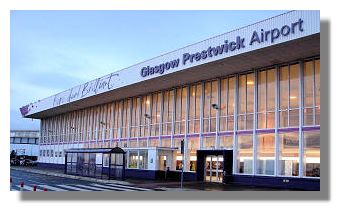 Even though it is 30 miles from Glasgow and causes confusion with the main airport which is just six miles from the centre of the city, Glasgow Prestwick Airport in Ayrshire is keen to retain the connection with Scotland's largest city. So when it was suggested that the airport should be redesignated "Robert Burns Airport" in honour of the 250th birthday of Scotland's national bard, the suggestion fell on deaf ears. The owners said a name change would confuse tourists (despite some travellers turning up at the wrong airport, mistaking it for Glasgow airport) and that Glasgow Prestwick was the right name, given that it is in Prestwick and its closest major city is Glasgow. On that reasoning, just wait for Oban Glasgow Airport...
Even though it is 30 miles from Glasgow and causes confusion with the main airport which is just six miles from the centre of the city, Glasgow Prestwick Airport in Ayrshire is keen to retain the connection with Scotland's largest city. So when it was suggested that the airport should be redesignated "Robert Burns Airport" in honour of the 250th birthday of Scotland's national bard, the suggestion fell on deaf ears. The owners said a name change would confuse tourists (despite some travellers turning up at the wrong airport, mistaking it for Glasgow airport) and that Glasgow Prestwick was the right name, given that it is in Prestwick and its closest major city is Glasgow. On that reasoning, just wait for Oban Glasgow Airport...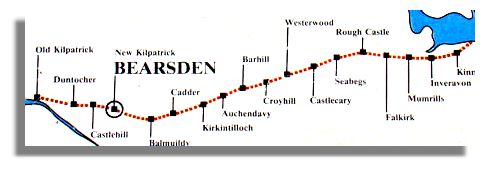 The Antonine Wall, built by the Romans across central Scotland, from the river Clyde to the river Forth, isn't visible from orbiting spacecraft in the same way as the Great wall of China. Indeed, it's hard to even see the wall on the ground. But this week Unesco's world heritage committee put it in the same august category by putting it in the same league as the Great Wall in China and the pyramids of Egypt. The Antonine Wall runs for 37 miles from Bo'ness in West Lothian to Old Kilpatrick in West Dunbartonshire (see map above). But unlike the stone-built Hadrian's wall further south (roughly along the border between Scotland and England) it was constructed of turf on a stone base. So much of it has been eroded and lost, leaving behind some ditches and a few bath houses used by the Roman garrison. The structure begun in 138 AD, during the reign of Antoninus Pius. It was designed to keep back marauding Caledonian tribesmen and marks the most northerly walled frontier of the Roman empire. A press conference was held this week at the well-preserved remains of a Roman bath-house and latrine, built in the 2nd century AD to serve a small fort in what is now Bearsden, East Dunbartonshire.
The Antonine Wall, built by the Romans across central Scotland, from the river Clyde to the river Forth, isn't visible from orbiting spacecraft in the same way as the Great wall of China. Indeed, it's hard to even see the wall on the ground. But this week Unesco's world heritage committee put it in the same august category by putting it in the same league as the Great Wall in China and the pyramids of Egypt. The Antonine Wall runs for 37 miles from Bo'ness in West Lothian to Old Kilpatrick in West Dunbartonshire (see map above). But unlike the stone-built Hadrian's wall further south (roughly along the border between Scotland and England) it was constructed of turf on a stone base. So much of it has been eroded and lost, leaving behind some ditches and a few bath houses used by the Roman garrison. The structure begun in 138 AD, during the reign of Antoninus Pius. It was designed to keep back marauding Caledonian tribesmen and marks the most northerly walled frontier of the Roman empire. A press conference was held this week at the well-preserved remains of a Roman bath-house and latrine, built in the 2nd century AD to serve a small fort in what is now Bearsden, East Dunbartonshire. 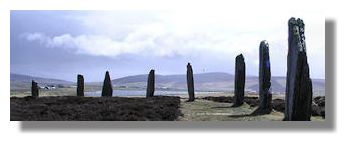 A team of archaeologists and scientists, including experts from Orkney College, the University of The Highlands and Islands, Manchester University and Stirling University, are undertaking a month-long investigation programme at Orkney's Ring of Brodgar, one of Western Europe’s most impressive prehistoric sites. The third largest stone circle in the British Isles is part of ‘The Heart of Neolithic Orkney’ World Heritage Site, designated by UNESCO in 1999. Little is known about the ancient site, including its exact age and purpose. The last major study there was in the 1970s and analytical techniques such as dating have advanced considerably since then. Trenches dug in 1973 will be re-excavated and there will be geophysical surveys - at least 40 stones can be identified but there are spaces for 20 more and the investigations should reveal what is actually there beneath the ground as well as above.
A team of archaeologists and scientists, including experts from Orkney College, the University of The Highlands and Islands, Manchester University and Stirling University, are undertaking a month-long investigation programme at Orkney's Ring of Brodgar, one of Western Europe’s most impressive prehistoric sites. The third largest stone circle in the British Isles is part of ‘The Heart of Neolithic Orkney’ World Heritage Site, designated by UNESCO in 1999. Little is known about the ancient site, including its exact age and purpose. The last major study there was in the 1970s and analytical techniques such as dating have advanced considerably since then. Trenches dug in 1973 will be re-excavated and there will be geophysical surveys - at least 40 stones can be identified but there are spaces for 20 more and the investigations should reveal what is actually there beneath the ground as well as above.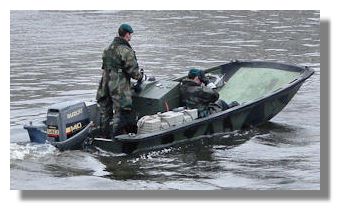 The Glasgow "Fair" holiday weekend of 19th/20th July sees the return of the action packed Glasgow River Festival, which takes place around Glasgow Harbour, the Scottish Exhibition and Conference Centre and the Glasgow Science Centre. Last year there were over 85,000 spectators and the programme this year should attract even more. There will be demonstrations by the (very noisy but exciting) Jet Skis with stunts and races and at a more leisurely pace, there will be boat trips down the river. A large number of vessels will be moored at the river bank, including the Clyde Puffers "Vital Spark" and "Spartan". Visitors will also be able to go on-board the Loth Loriën schooner, two Royal Navy Hunt class minesweepers and the Jacinta, a Fleetwood trawler, which now acts as a floating museum of deep sea fisheries. And of course there is the "Great Glasgow Duck Race" - visitors can sponsor a plastic duck for £1, with the fastest duck winning its owner a prize. All proceeds will go to the Variety Club of Scotland.
The Glasgow "Fair" holiday weekend of 19th/20th July sees the return of the action packed Glasgow River Festival, which takes place around Glasgow Harbour, the Scottish Exhibition and Conference Centre and the Glasgow Science Centre. Last year there were over 85,000 spectators and the programme this year should attract even more. There will be demonstrations by the (very noisy but exciting) Jet Skis with stunts and races and at a more leisurely pace, there will be boat trips down the river. A large number of vessels will be moored at the river bank, including the Clyde Puffers "Vital Spark" and "Spartan". Visitors will also be able to go on-board the Loth Loriën schooner, two Royal Navy Hunt class minesweepers and the Jacinta, a Fleetwood trawler, which now acts as a floating museum of deep sea fisheries. And of course there is the "Great Glasgow Duck Race" - visitors can sponsor a plastic duck for £1, with the fastest duck winning its owner a prize. All proceeds will go to the Variety Club of Scotland.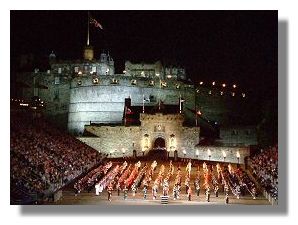 There will be more than 1,000 performers from America, Asia, Australia, New Zealand, Europe and the UK at this year's Edinburgh Military Tattoo which starts next week and runs to 23 August. It is being televised by BBC1 on 23 August. In addition to the long-established massed pipes and drums and the lone piper on Edinburgh Castle battlements at the end of the show, there will be the first performance by an Indian military band in 46 years, with 40 musicians from the Indian Army Chief's Military Band. Melbourne's Rats of Tobruk from Australia will be making their sixth appearance at the Tattoo, while the Singapore Police Gurkha Pipes and drums are returning to Edinburgh after a 17-year absence. The 100-strong Golden Eagles Marching Band from South East Missouri is also performing and the all-girl Lochiel Champion Marching Drill Team from Wellington in New Zealand. is making a return visit to the sell-out show.
There will be more than 1,000 performers from America, Asia, Australia, New Zealand, Europe and the UK at this year's Edinburgh Military Tattoo which starts next week and runs to 23 August. It is being televised by BBC1 on 23 August. In addition to the long-established massed pipes and drums and the lone piper on Edinburgh Castle battlements at the end of the show, there will be the first performance by an Indian military band in 46 years, with 40 musicians from the Indian Army Chief's Military Band. Melbourne's Rats of Tobruk from Australia will be making their sixth appearance at the Tattoo, while the Singapore Police Gurkha Pipes and drums are returning to Edinburgh after a 17-year absence. The 100-strong Golden Eagles Marching Band from South East Missouri is also performing and the all-girl Lochiel Champion Marching Drill Team from Wellington in New Zealand. is making a return visit to the sell-out show.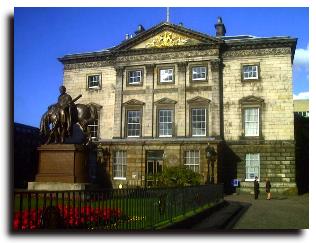 The Royal Bank of Scotland (RBS) announced this week that it had made a pre-tax loss of £691 million during the first six months of 2008 - the second biggest loss in UK banking history and the first time that RBS had made a loss for 40 years. The cause was of course write-downs after the credit crunch cut the value of its mortgages and assets, with the bank taking a £5.9 billion hit. RBS had been expected by analysts to post a much larger loss - speculation ranged as high as £1.7 billion. But creative accounting (and/or encouraging financial analysts to go for higher figures) meant that the bank's shares rose 2.7% following the better than expected announcement. There is a hope that if the bank has fully come clean on its losses, it could still produce an overall profit for the full year. Chief Executive Sir Fred Goodwin, not known for a lack of confidence, said that the losses had been a "chastening experience" and that reporting a shortfall of £691m was something he and his colleagues "regret very much". Putting a better gloss on the picture, he said also that the write-downs created, "a very unsatisfactory situation, made more so by the shadow it casts over the good performances across a wide range of our businesses".
The Royal Bank of Scotland (RBS) announced this week that it had made a pre-tax loss of £691 million during the first six months of 2008 - the second biggest loss in UK banking history and the first time that RBS had made a loss for 40 years. The cause was of course write-downs after the credit crunch cut the value of its mortgages and assets, with the bank taking a £5.9 billion hit. RBS had been expected by analysts to post a much larger loss - speculation ranged as high as £1.7 billion. But creative accounting (and/or encouraging financial analysts to go for higher figures) meant that the bank's shares rose 2.7% following the better than expected announcement. There is a hope that if the bank has fully come clean on its losses, it could still produce an overall profit for the full year. Chief Executive Sir Fred Goodwin, not known for a lack of confidence, said that the losses had been a "chastening experience" and that reporting a shortfall of £691m was something he and his colleagues "regret very much". Putting a better gloss on the picture, he said also that the write-downs created, "a very unsatisfactory situation, made more so by the shadow it casts over the good performances across a wide range of our businesses". Edinburgh’s last remaining brewery will be rolling out the barrels at one of the largest international events being held in Scotland next year. The Gathering 2009 has secured a deal with the Caledonian Brewing Company, which will see the brewer sponsor a major part of the Highland Games in the capital’s Holyrood Park on 25 and 26 July 2009. As a result of the deal, its award-winning brand, Deuchars IPA, will give its name to the Deuchars World Highland Games Heavy Events Championship as well as become the official beer of The Gathering 2009. The Gathering 2009 is one of the key events of next year’s Homecoming Scotland programme and is expected to be the largest international clan gathering and Highland Games ever held in this country. Around 8000 clans people from around the world will take part in a parade along the Royal Mile and an anticipated 40,000 visitors will attend the Highland Games where the Heavy Events Championship will take place. With one year to go until the event, members from 140 clans have already booked their place in the Clan Parade, and 110 of those clans will have a presence in the clan village in Holyrood Park. Tickets and Passports to The Gathering 2009 are available from
Edinburgh’s last remaining brewery will be rolling out the barrels at one of the largest international events being held in Scotland next year. The Gathering 2009 has secured a deal with the Caledonian Brewing Company, which will see the brewer sponsor a major part of the Highland Games in the capital’s Holyrood Park on 25 and 26 July 2009. As a result of the deal, its award-winning brand, Deuchars IPA, will give its name to the Deuchars World Highland Games Heavy Events Championship as well as become the official beer of The Gathering 2009. The Gathering 2009 is one of the key events of next year’s Homecoming Scotland programme and is expected to be the largest international clan gathering and Highland Games ever held in this country. Around 8000 clans people from around the world will take part in a parade along the Royal Mile and an anticipated 40,000 visitors will attend the Highland Games where the Heavy Events Championship will take place. With one year to go until the event, members from 140 clans have already booked their place in the Clan Parade, and 110 of those clans will have a presence in the clan village in Holyrood Park. Tickets and Passports to The Gathering 2009 are available from 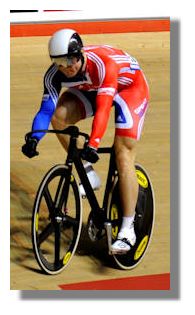 Chris Hoy has made history at the Olympic games in Beijing by winning three gold medals in the cycling events. The Edinburgh athlete became the first Briton in 100 years to win three golds in the same Olympic games and the most successful Scottish Olympian - he also won a gold medal in the one kilometre cycling time trials in the Athens Olympics in 2004. When they return home, Hoy and other Scottish Olympic medalists and participants, who helped Britain to their best Olympic medal haul for 100 years, will ride in an open top bus down the Royal Mile in Edinburgh after attending a reception at the city's castle. Aberdeen canoeist David Florence was runner-up in the slalom, while rower Katherine Grainier also won silver (her third - she has won silver in three consecutive Olympics).
Chris Hoy has made history at the Olympic games in Beijing by winning three gold medals in the cycling events. The Edinburgh athlete became the first Briton in 100 years to win three golds in the same Olympic games and the most successful Scottish Olympian - he also won a gold medal in the one kilometre cycling time trials in the Athens Olympics in 2004. When they return home, Hoy and other Scottish Olympic medalists and participants, who helped Britain to their best Olympic medal haul for 100 years, will ride in an open top bus down the Royal Mile in Edinburgh after attending a reception at the city's castle. Aberdeen canoeist David Florence was runner-up in the slalom, while rower Katherine Grainier also won silver (her third - she has won silver in three consecutive Olympics).
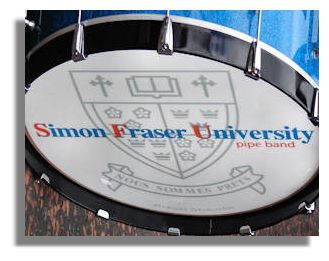 The Simon Fraser University Pipe Band has been consistently placed in the top three in world competition in the last 25 years. Last Saturday the band won the Grade One World Pipe Band Championships for the fifth time, having just missed out on other occasions since their last win in 2001 - they have been placed second seven times in the last 25 years. The band is affiliated to Simon Fraser University in Burnaby, British Columbia, Canada (a suburb located just east of Vancouver). This year, Simon Fraser University band beat last year's winners, Field Marshal Montgomery from Northern Ireland into second place. Scotland's House of Edgar-Shotts & Dykehead were in third place. See
The Simon Fraser University Pipe Band has been consistently placed in the top three in world competition in the last 25 years. Last Saturday the band won the Grade One World Pipe Band Championships for the fifth time, having just missed out on other occasions since their last win in 2001 - they have been placed second seven times in the last 25 years. The band is affiliated to Simon Fraser University in Burnaby, British Columbia, Canada (a suburb located just east of Vancouver). This year, Simon Fraser University band beat last year's winners, Field Marshal Montgomery from Northern Ireland into second place. Scotland's House of Edgar-Shotts & Dykehead were in third place. See 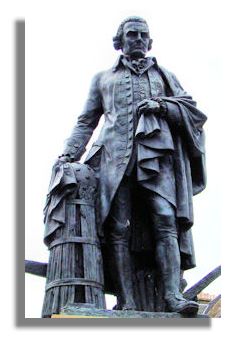 The world's first statue to the Scottish economist and philosopher, Adam Smith, has been unveiled in Edinburgh's historic High Street, beside St Giles Cathedral and opposite the City Chambers, the seat of local government in the city. Adam Smith (1723-1790) taught at Glasgow University and is buried in Canongate Kirkyard in Edinburgh. Smith was one of the key figures of the intellectual movement known as the Scottish Enlightenment. He is best known for his treatise "An Inquiry into the Nature and Causes of the Wealth of Nations", commonly known as The Wealth of Nations. Smith is also known for his explanation of how rational self-interest and how competition can lead to economic well-being and prosperity. His work helped to create the modern academic discipline of economics and provided one of the best-known rationales for free trade. He is widely acknowledged as the "father of economics".
The world's first statue to the Scottish economist and philosopher, Adam Smith, has been unveiled in Edinburgh's historic High Street, beside St Giles Cathedral and opposite the City Chambers, the seat of local government in the city. Adam Smith (1723-1790) taught at Glasgow University and is buried in Canongate Kirkyard in Edinburgh. Smith was one of the key figures of the intellectual movement known as the Scottish Enlightenment. He is best known for his treatise "An Inquiry into the Nature and Causes of the Wealth of Nations", commonly known as The Wealth of Nations. Smith is also known for his explanation of how rational self-interest and how competition can lead to economic well-being and prosperity. His work helped to create the modern academic discipline of economics and provided one of the best-known rationales for free trade. He is widely acknowledged as the "father of economics". This year's Edinburgh Fringe, the world’s largest arts festival, got under way in the Scottish capital last weekend - despite a technology failure that threatened to derail ticketing for thousands of theatregoers. The 62nd annual event runs until 25 August and an estimated 18,792 performers from 46 countries will present 31,320 performances of 2,088 shows in 247 venues. Four of the main venues (Assembly, Gilded Balloon, Pleasance and Underbelly) are joining forces for the first time to create a "festival-within-a-festival" at the Fringe, the Edinburgh Comedy Festival, to showcase their 253 stand-up contributions to this year’s event. Over half a million people are expected to visit Edinburgh in August to take in the different festivals staged during the month. In addition to the Fringe and the main Edinburgh International Festival, there is the Military Tattoo, the Film Festival and the Book Festival. But the Fringe is by far the largest event, with around 75% of the "market share".
This year's Edinburgh Fringe, the world’s largest arts festival, got under way in the Scottish capital last weekend - despite a technology failure that threatened to derail ticketing for thousands of theatregoers. The 62nd annual event runs until 25 August and an estimated 18,792 performers from 46 countries will present 31,320 performances of 2,088 shows in 247 venues. Four of the main venues (Assembly, Gilded Balloon, Pleasance and Underbelly) are joining forces for the first time to create a "festival-within-a-festival" at the Fringe, the Edinburgh Comedy Festival, to showcase their 253 stand-up contributions to this year’s event. Over half a million people are expected to visit Edinburgh in August to take in the different festivals staged during the month. In addition to the Fringe and the main Edinburgh International Festival, there is the Military Tattoo, the Film Festival and the Book Festival. But the Fringe is by far the largest event, with around 75% of the "market share". Travis, one of Scotland's most successful rock acts of the last decade, have announced that they will begin the tour to promote their latest album "Ode to J Smith" in Inverness on 22nd September. Thereafter, the band will go on to play shows in Aberdeen and Edinburgh before moving on to the English leg of their autumn tour. Travis are a Scottish Indie pop band from Glasgow who have twice been awarded British album of the year at the annual BRIT Awards, and are often credited with having paved the way for bands such as Coldplay, Keane and Snow Patrol. They have released five studio albums, beginning with their debut, "Good Feeling" in 1997. Their most recent album was "The Boy with No Name" published in 2007.
Travis, one of Scotland's most successful rock acts of the last decade, have announced that they will begin the tour to promote their latest album "Ode to J Smith" in Inverness on 22nd September. Thereafter, the band will go on to play shows in Aberdeen and Edinburgh before moving on to the English leg of their autumn tour. Travis are a Scottish Indie pop band from Glasgow who have twice been awarded British album of the year at the annual BRIT Awards, and are often credited with having paved the way for bands such as Coldplay, Keane and Snow Patrol. They have released five studio albums, beginning with their debut, "Good Feeling" in 1997. Their most recent album was "The Boy with No Name" published in 2007.  The Scottish Government this week laid out its programme for the year ahead. There are 15 bills, including proposals for replacing Council Tax with an increase in the basic rate of income tax by 3%, tackling climate change and strengthening the criminal justice system. There will be tougher legislation on the sale of alcohol and tobacco, particularly to young people, with an increase to 21 for the sale of alcohol and levying a "social responsibility" fee on pubs and clubs. The referendum on whether or not Scotland should leave the United Kingdom will not be introduced until 2010. The First Minister said he had a "single over-arching purpose to increase sustainable growth" and "that purpose is supported by our strategic objectives of building a Scotland that is safer and stronger, greener, healthier, smarter, wealthier and fairer." You can read the full statement on the programme made by the First Minister to the Scottish Parliament at
The Scottish Government this week laid out its programme for the year ahead. There are 15 bills, including proposals for replacing Council Tax with an increase in the basic rate of income tax by 3%, tackling climate change and strengthening the criminal justice system. There will be tougher legislation on the sale of alcohol and tobacco, particularly to young people, with an increase to 21 for the sale of alcohol and levying a "social responsibility" fee on pubs and clubs. The referendum on whether or not Scotland should leave the United Kingdom will not be introduced until 2010. The First Minister said he had a "single over-arching purpose to increase sustainable growth" and "that purpose is supported by our strategic objectives of building a Scotland that is safer and stronger, greener, healthier, smarter, wealthier and fairer." You can read the full statement on the programme made by the First Minister to the Scottish Parliament at  Despite soaring fuel and insurance costs, the number of vehicles on Scotland's roads continues to rise. In less than ten years the number of licensed vehicles has increased by almost a third. Scottish Government figures show that there are now 2.65 million vehicles on the roads. Although car sales have declined this year, there was a 3% increase last year in new vehicle registrations. Despite the record levels of road traffic, casualty numbers from road accidents are falling, with 10% fewer people killed and 12% fewer seriously injured. The number of passenger journeys on local bus services and the railways has also been growing - numbers using ScotRail services increased 5% last year to the highest level for 40 years. Rail passenger numbers are now 45% higher than ten years ago. The number of passengers using Scotland's air terminals also reached a new record - 25.1 million, up 3% on the previous year. Despite all those extra journeys, the statistics also report that the percentage of the population who said they had walked for pleasure or to keep fit had also increased since 1999.
Despite soaring fuel and insurance costs, the number of vehicles on Scotland's roads continues to rise. In less than ten years the number of licensed vehicles has increased by almost a third. Scottish Government figures show that there are now 2.65 million vehicles on the roads. Although car sales have declined this year, there was a 3% increase last year in new vehicle registrations. Despite the record levels of road traffic, casualty numbers from road accidents are falling, with 10% fewer people killed and 12% fewer seriously injured. The number of passenger journeys on local bus services and the railways has also been growing - numbers using ScotRail services increased 5% last year to the highest level for 40 years. Rail passenger numbers are now 45% higher than ten years ago. The number of passengers using Scotland's air terminals also reached a new record - 25.1 million, up 3% on the previous year. Despite all those extra journeys, the statistics also report that the percentage of the population who said they had walked for pleasure or to keep fit had also increased since 1999.  A designer, who has previously created tartan for ten European countries including Poland, France and Norway, has now come up with one for Japan. The design by David McGill from Edinburgh is named "Sakura" - the Javanese word for cherry blossom. So it is predominantly pink with white, green and brown. The inspiration was not just cherry blossom, but Fraserburgh-born Thomas Glover (1838-1911), the "Scottish Samurai" who did much to establish modern industrialisation in Japan. There are now an estimated 7,000 different tartans, with 150 new designs being created every year.
A designer, who has previously created tartan for ten European countries including Poland, France and Norway, has now come up with one for Japan. The design by David McGill from Edinburgh is named "Sakura" - the Javanese word for cherry blossom. So it is predominantly pink with white, green and brown. The inspiration was not just cherry blossom, but Fraserburgh-born Thomas Glover (1838-1911), the "Scottish Samurai" who did much to establish modern industrialisation in Japan. There are now an estimated 7,000 different tartans, with 150 new designs being created every year.  Bank of Scotland was established in 1695 by an act of the Scottish Parliament. In 2001 it merged with Halifax, Britain’s largest mortgage provider, to form HBOS - a move which also put it in the top league of world banks. But this week it was forced into being taken over by Lloyds TSB to create a banking colossus that in normal times would never have been allowed by the competition authorities - the new bank will have a 28% of all mortgage loans in the UK, more than twice its nearest rival. However, the merger is even said to have been pushed by the UK Prime Minister, Gordon Brown as HBOS faced an unprecedented fall in the value of its shares, crashing from 308.5p on 9 September to a low of just 88p - though it recovered slightly from that level. Analysts said that HBOS needed to refinance over £100 billion of funding in the next few months, which was quite a challenge after the financial turmoil and the lack of confidence in the market after the collapse of Lehman brothers. The bank claimed it was "very confident" about its funding position, pointing to its £258 billion of retail deposits for 15 million savers as the UK's largest savings institution. But credit rating agency Standard & Poor downgraded HBOS and billions were wiped off its market value.
Bank of Scotland was established in 1695 by an act of the Scottish Parliament. In 2001 it merged with Halifax, Britain’s largest mortgage provider, to form HBOS - a move which also put it in the top league of world banks. But this week it was forced into being taken over by Lloyds TSB to create a banking colossus that in normal times would never have been allowed by the competition authorities - the new bank will have a 28% of all mortgage loans in the UK, more than twice its nearest rival. However, the merger is even said to have been pushed by the UK Prime Minister, Gordon Brown as HBOS faced an unprecedented fall in the value of its shares, crashing from 308.5p on 9 September to a low of just 88p - though it recovered slightly from that level. Analysts said that HBOS needed to refinance over £100 billion of funding in the next few months, which was quite a challenge after the financial turmoil and the lack of confidence in the market after the collapse of Lehman brothers. The bank claimed it was "very confident" about its funding position, pointing to its £258 billion of retail deposits for 15 million savers as the UK's largest savings institution. But credit rating agency Standard & Poor downgraded HBOS and billions were wiped off its market value.  The take-over means the loss of a prestigious corporate banking HQ in Edinburgh (pictured here) and big losses for long-term shareholders, including pension funds, who have seen HBOS shares slump from over 1000p less than 18 months ago to a likely takeover price of around 200p depending on the value of Lloyds TSB shares. The take-over also poses a threat to the jobs of tens of thousands of staff in administration functions and in the branch network where the two banks overlap. HBOS has more than 17,000 staff in Scotland, while Lloyds TSB employs more than 7,000. The combined staff of the banks across the UK would be around 140,000. It is understood that the Bank of Scotland will retain its building on The Mound in Edinburgh as its Scottish HQ and will continue to issue its own banknotes and the branches will continue to be branded as Bank of Scotland.
The take-over means the loss of a prestigious corporate banking HQ in Edinburgh (pictured here) and big losses for long-term shareholders, including pension funds, who have seen HBOS shares slump from over 1000p less than 18 months ago to a likely takeover price of around 200p depending on the value of Lloyds TSB shares. The take-over also poses a threat to the jobs of tens of thousands of staff in administration functions and in the branch network where the two banks overlap. HBOS has more than 17,000 staff in Scotland, while Lloyds TSB employs more than 7,000. The combined staff of the banks across the UK would be around 140,000. It is understood that the Bank of Scotland will retain its building on The Mound in Edinburgh as its Scottish HQ and will continue to issue its own banknotes and the branches will continue to be branded as Bank of Scotland.  An appeal has been launched to allow the trustees of the Black Watch Regimental Museum to buy Balhousie Castle in Perth (seen here), where it is housed. The Ministry of Defence wants to sell the castle and over £3 million is needed to purchase the building and develop it. The castle dates back to the 15th century and in 1962 it became the regimental headquarters of the Black Watch and its regimental museum. The museum does an excellent job of showing the story of the regiment from its founding in 1739, through all the major conflicts in which the Black Watch participated - right up to the present day, when it was merged in 2006 (with the other Scottish regiments) into the Royal Regiment of Scotland, becoming a battalion in that unit. The museum trustees want to expand the facilities to ensure that the history of The Black Watch is preserved for future generations. See
An appeal has been launched to allow the trustees of the Black Watch Regimental Museum to buy Balhousie Castle in Perth (seen here), where it is housed. The Ministry of Defence wants to sell the castle and over £3 million is needed to purchase the building and develop it. The castle dates back to the 15th century and in 1962 it became the regimental headquarters of the Black Watch and its regimental museum. The museum does an excellent job of showing the story of the regiment from its founding in 1739, through all the major conflicts in which the Black Watch participated - right up to the present day, when it was merged in 2006 (with the other Scottish regiments) into the Royal Regiment of Scotland, becoming a battalion in that unit. The museum trustees want to expand the facilities to ensure that the history of The Black Watch is preserved for future generations. See  An on-line database has been launched with the names of four million Britons, many of them Scots, who sailed to Canada in the 19th and 20th centuries to seek a new life in one of the largest-scale migrations in Britain's history. The records also include many holidaymakers and travellers, businesspeople, crew members and historical figures such as foreign leaders, scientists and celebrities. They include Alexander Graham Bell, who emigrated from Edinburgh to Ontario in 1870 to continue working on his invention of the telephone. And Falkirk-born Tommy Douglas, who moved with his family to Winnipeg in 1910 and later founded Canada's universal public healthcare. 150,000 foster children sent overseas alone as part of the Child Emigration Scheme at the end of the 19th and start of the 20th centuries are also included. The database is fully indexed and searchable, with information including passengers' first and last names, estimated birth years, years of arrival, ports of arrival and departure, ship names, occupations and final destinations in Canada. See the
An on-line database has been launched with the names of four million Britons, many of them Scots, who sailed to Canada in the 19th and 20th centuries to seek a new life in one of the largest-scale migrations in Britain's history. The records also include many holidaymakers and travellers, businesspeople, crew members and historical figures such as foreign leaders, scientists and celebrities. They include Alexander Graham Bell, who emigrated from Edinburgh to Ontario in 1870 to continue working on his invention of the telephone. And Falkirk-born Tommy Douglas, who moved with his family to Winnipeg in 1910 and later founded Canada's universal public healthcare. 150,000 foster children sent overseas alone as part of the Child Emigration Scheme at the end of the 19th and start of the 20th centuries are also included. The database is fully indexed and searchable, with information including passengers' first and last names, estimated birth years, years of arrival, ports of arrival and departure, ship names, occupations and final destinations in Canada. See the  Nearly 2,000 Harley Davidson motorcycles roared into Aviemore a couple of weekends ago. It was the most successful "Thunder in the Glens" event ever as bikers from as far away as Germany and Ireland turned up to meet other enthusiasts. All the bikers rode out of Aviemore in a mass exodus to Grantown, about 15 miles away, watched by crowds of onlookers. Aviemore's hostelries were packed out and hundreds attended music events at the rally’s main base at the Macdonald Aviemore Highland Resort. Two Harley Davidson fans took their machines on the funicular railway to the Ptarmigan Restaurant and got married at the top of the Cairn Gorm mountain. The event wasn't all about paying homage to the Harley Davidson machine, however - the bikers raised around £20,000 for charity from auctions and raffles throughout the weekend.
Nearly 2,000 Harley Davidson motorcycles roared into Aviemore a couple of weekends ago. It was the most successful "Thunder in the Glens" event ever as bikers from as far away as Germany and Ireland turned up to meet other enthusiasts. All the bikers rode out of Aviemore in a mass exodus to Grantown, about 15 miles away, watched by crowds of onlookers. Aviemore's hostelries were packed out and hundreds attended music events at the rally’s main base at the Macdonald Aviemore Highland Resort. Two Harley Davidson fans took their machines on the funicular railway to the Ptarmigan Restaurant and got married at the top of the Cairn Gorm mountain. The event wasn't all about paying homage to the Harley Davidson machine, however - the bikers raised around £20,000 for charity from auctions and raffles throughout the weekend.
 The Vodafone Live Music Awards this week named the T in the Park rock festival at Balado near Kinross as the "festival of the year". And Scottish group Primal Scream received Best Live Act and Outstanding Contribution to Live Music prizes. This was the 15th year of the popular T in the Park rock festival which is Scotland's biggest event of this kind. This year it had 114 bands on six stages over more than three days of performances
The Vodafone Live Music Awards this week named the T in the Park rock festival at Balado near Kinross as the "festival of the year". And Scottish group Primal Scream received Best Live Act and Outstanding Contribution to Live Music prizes. This was the 15th year of the popular T in the Park rock festival which is Scotland's biggest event of this kind. This year it had 114 bands on six stages over more than three days of performances

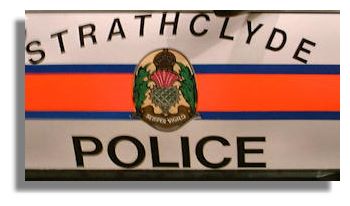 Scottish government justice secretary Kenny MacAskill this week welcomed a fall in recorded crime in Scotland with figures showing it was at its lowest level in a quarter of a century. All crime, including murder and attempted murder, has declined and even figures for vandalism fell last year. But as with all statistics, the data has to be treated with some caution. The figures only tally the number of crimes "reported" to the police and regrettably many members of the public believe that there is little point in reporting crime - or are fearful of reprisals if they get involved. Nevertheless, the data is measured each year on a similar basis so some comfort can be taken from the decline.
Scottish government justice secretary Kenny MacAskill this week welcomed a fall in recorded crime in Scotland with figures showing it was at its lowest level in a quarter of a century. All crime, including murder and attempted murder, has declined and even figures for vandalism fell last year. But as with all statistics, the data has to be treated with some caution. The figures only tally the number of crimes "reported" to the police and regrettably many members of the public believe that there is little point in reporting crime - or are fearful of reprisals if they get involved. Nevertheless, the data is measured each year on a similar basis so some comfort can be taken from the decline.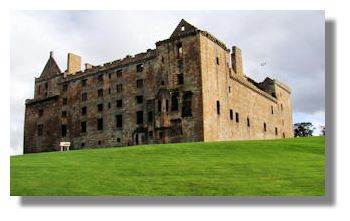 Wet weather and the credit crunch were being blamed for a 10% fall in the number of visitors this summer to the tourist attractions maintained by Historic Scotland, the government's agency responsible for historic monuments across the country. Between April and September, 1.9 million people visited the organisation's 360 attractions, 216,00 fewer than in the same period last year. Edinburgh Castle, the "jewel in the crown", saw a decline in numbers of 13% and other main attractions such as Stirling Castle, Linlithgow Palace (pictured here), Melrose Abbey and Caerlaverock Castle near Dumfries all saw a fall in visitor numbers.
Wet weather and the credit crunch were being blamed for a 10% fall in the number of visitors this summer to the tourist attractions maintained by Historic Scotland, the government's agency responsible for historic monuments across the country. Between April and September, 1.9 million people visited the organisation's 360 attractions, 216,00 fewer than in the same period last year. Edinburgh Castle, the "jewel in the crown", saw a decline in numbers of 13% and other main attractions such as Stirling Castle, Linlithgow Palace (pictured here), Melrose Abbey and Caerlaverock Castle near Dumfries all saw a fall in visitor numbers.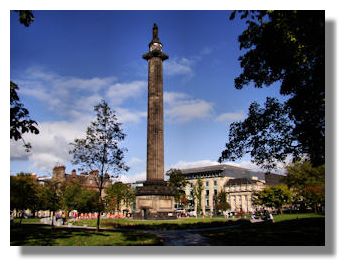 One of the features of Edinburgh's 18th century "New Town" was the creation of a good number of squares with gardens in their centre. But the gardens were not open to the public - residents in the surrounding houses paid for their upkeep and had keys to allow them entry and they were treated as private gardens. Even though these days most of the buildings around these squares are now occupied by offices or hotels, the tradition has been maintained. However, last month St Andrew Square, one of the cornerstones of the masterpiece of town planning laid out by James Craig in 1766, has been opened up after a £2.6 million makeover. It is the first time the garden area has been open to the public since 1770. The new facility was opened by First Minister Alex Salmond - who recalled that he had once worked in the Royal Bank of Scotland's main office overlooking the square. Now pedestrians no longer have to walk round the fenced-in garden but can walk through - and stop for a coffee at a discreet coffee shop in the corner. In the centre of the square is a monument erected in 1823 to Henry Dundas, Viscount Melville, who was described as "the absolute dictator of Scotland".
One of the features of Edinburgh's 18th century "New Town" was the creation of a good number of squares with gardens in their centre. But the gardens were not open to the public - residents in the surrounding houses paid for their upkeep and had keys to allow them entry and they were treated as private gardens. Even though these days most of the buildings around these squares are now occupied by offices or hotels, the tradition has been maintained. However, last month St Andrew Square, one of the cornerstones of the masterpiece of town planning laid out by James Craig in 1766, has been opened up after a £2.6 million makeover. It is the first time the garden area has been open to the public since 1770. The new facility was opened by First Minister Alex Salmond - who recalled that he had once worked in the Royal Bank of Scotland's main office overlooking the square. Now pedestrians no longer have to walk round the fenced-in garden but can walk through - and stop for a coffee at a discreet coffee shop in the corner. In the centre of the square is a monument erected in 1823 to Henry Dundas, Viscount Melville, who was described as "the absolute dictator of Scotland".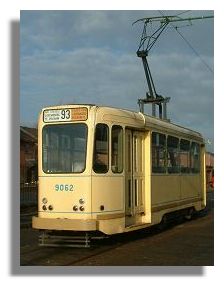 Summerlee, the Museum of Scottish Industrial life, built on the site of a former ironworks in Coatbridge in North Lanarkshire, has reopened after a two-year £10.5 million redevelopment. Although it showcases the industrial history of Scotland, there is a particular emphasis on Lanarkshire. The museum used to be called "the noisiest" in Scotland and it still has a restored winding engine from the former Cardowan Colliery at Stepps, a 19th century steam locomotive, and working machinery demonstrating how steel and iron were produced. There is also an operating tram car (the only one in Scotland) which takes visitors to a coal mine site and miners' cottages displaying interiors as they looked from 1840 to 1960.
Summerlee, the Museum of Scottish Industrial life, built on the site of a former ironworks in Coatbridge in North Lanarkshire, has reopened after a two-year £10.5 million redevelopment. Although it showcases the industrial history of Scotland, there is a particular emphasis on Lanarkshire. The museum used to be called "the noisiest" in Scotland and it still has a restored winding engine from the former Cardowan Colliery at Stepps, a 19th century steam locomotive, and working machinery demonstrating how steel and iron were produced. There is also an operating tram car (the only one in Scotland) which takes visitors to a coal mine site and miners' cottages displaying interiors as they looked from 1840 to 1960.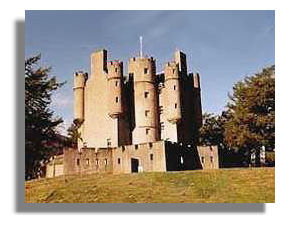 Braemar Castle in Aberdeenshire was a stronghold of the Earls of Mar but latterly the castle was returned to the Farquharson clan and is regarded as the ancestral home of the clan. But it became surplus to requirements in 2006 and was about to be sold. A local community group persuaded the Farquharsons to lease the castle to them for 50 years and, with the help of lottery funding, have undertaken a major makeover of the castle. It reopened to the public at weekends in May this year, after being closed for three years. This week the castle and the volunteers who worked miracles on restoring the building had a visit from one of their near neighbours - Prince Charles who stays at Balmoral Castle from time to time. In the drawing room he was shown a copy of his late grandmother's signature from a visit she made on the same date in 1956. For more on Braemar Castle and its refurbishment, see
Braemar Castle in Aberdeenshire was a stronghold of the Earls of Mar but latterly the castle was returned to the Farquharson clan and is regarded as the ancestral home of the clan. But it became surplus to requirements in 2006 and was about to be sold. A local community group persuaded the Farquharsons to lease the castle to them for 50 years and, with the help of lottery funding, have undertaken a major makeover of the castle. It reopened to the public at weekends in May this year, after being closed for three years. This week the castle and the volunteers who worked miracles on restoring the building had a visit from one of their near neighbours - Prince Charles who stays at Balmoral Castle from time to time. In the drawing room he was shown a copy of his late grandmother's signature from a visit she made on the same date in 1956. For more on Braemar Castle and its refurbishment, see 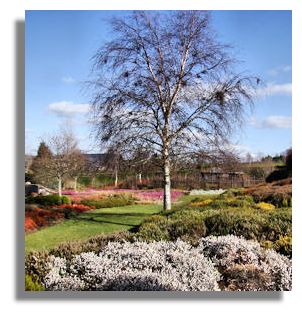 There was an outcry when Bell's Cherrybank Garden in Perth was closed earlier this year. It contained a national heather collection and was a popular and well-loved facility used by locals and tourists alike. The closure arose because of a failure of the grandiose "Calyx" project to gain lottery funding for a multi-million pound "Scotland's Garden" which would have incorporated Cherrybank. Now Perth and Kinross Council's Leisure subsidiary has negotiated with Scotland's Garden Trust to take over the property. The former visitor centre building will be sold and the proceeds used to fund the Garden Trust's Calyx project. The gardens have been maintained since July by Perth and Kinross Leisure and after essential upgrades have been completed the gardens with their wonderful heather collection will open again - with free entry.
There was an outcry when Bell's Cherrybank Garden in Perth was closed earlier this year. It contained a national heather collection and was a popular and well-loved facility used by locals and tourists alike. The closure arose because of a failure of the grandiose "Calyx" project to gain lottery funding for a multi-million pound "Scotland's Garden" which would have incorporated Cherrybank. Now Perth and Kinross Council's Leisure subsidiary has negotiated with Scotland's Garden Trust to take over the property. The former visitor centre building will be sold and the proceeds used to fund the Garden Trust's Calyx project. The gardens have been maintained since July by Perth and Kinross Leisure and after essential upgrades have been completed the gardens with their wonderful heather collection will open again - with free entry. The annual celebration of Gaelic language and culture took place in Falkirk this week, attracting 10,000 visitors, including 2,000 competitors, from across the world. The Mod has been held each year since 1892 and there are over 200 competitions in all. Throughout the mod there were also shows by Gaelic performers in pubs and clubs. This was the first time that the event has been held in Falkirk and it will provide a useful economic boost to the town. Next year the Mod will be held in Oban and in 2010 it will be Thurso. This week the organisers opted for the Western Isles in 2011 - regarded by many as the Mod's "spiritual home" due to the larger number of native Gaelic speakers. A strong bid to host the 2011 event in Paisley just lost out, even though (like Falkirk) it is not immediately associated with Gaelic culture.
The annual celebration of Gaelic language and culture took place in Falkirk this week, attracting 10,000 visitors, including 2,000 competitors, from across the world. The Mod has been held each year since 1892 and there are over 200 competitions in all. Throughout the mod there were also shows by Gaelic performers in pubs and clubs. This was the first time that the event has been held in Falkirk and it will provide a useful economic boost to the town. Next year the Mod will be held in Oban and in 2010 it will be Thurso. This week the organisers opted for the Western Isles in 2011 - regarded by many as the Mod's "spiritual home" due to the larger number of native Gaelic speakers. A strong bid to host the 2011 event in Paisley just lost out, even though (like Falkirk) it is not immediately associated with Gaelic culture.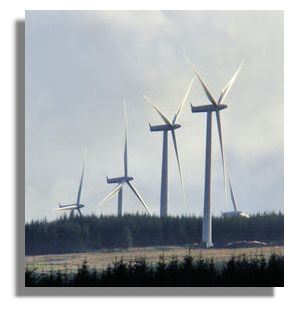 The amount of renewable energy generating capacity in Scotland passed the three gigawatt level this week, with the opening of two new wind farms. The landmark was confirmed by the Scottish Government Energy Minister as he officially opened the wind farms on "Green Energy Day". More than half of the renewable energy is now being produced by wind power, the rest by long established hydro-electric schemes and some biomass power stations. Since May last year, 14 renewable applications up and down the country have been approved, including the Clyde wind farm, currently the largest single consented wind farm in Europe. Five years ago, a target of 18% of Scotland's energy production from renewables by 2010 looked challenging. But that has already been met - several years early - and the industry is now focused on meeting the next target of 50% renewable energy production by 2020.
The amount of renewable energy generating capacity in Scotland passed the three gigawatt level this week, with the opening of two new wind farms. The landmark was confirmed by the Scottish Government Energy Minister as he officially opened the wind farms on "Green Energy Day". More than half of the renewable energy is now being produced by wind power, the rest by long established hydro-electric schemes and some biomass power stations. Since May last year, 14 renewable applications up and down the country have been approved, including the Clyde wind farm, currently the largest single consented wind farm in Europe. Five years ago, a target of 18% of Scotland's energy production from renewables by 2010 looked challenging. But that has already been met - several years early - and the industry is now focused on meeting the next target of 50% renewable energy production by 2020. During October, Andy Murray from Dunblane, who had reached the final of the New York Open Championship in September, continued a successful tennis season by winning his second Masters title, this time in Madrid. He had defeated the World Number 2, Roger Federer, in the semi-final. It would have been a surprise if Andy had then lost to Frenchman Gilles Simon and indeed he won comfortably 6-4, 7-6 (8-6). In so doing, he became the first British player to win two titles at the elite Masters level in a season, having won the Cincinnati title in August. Andy Murray then followed that up by retaining his St Petersburg Open title to continue his successful winning form. However, after easing through the earlier rounds, Andy's superb winning run came to an end in the quarter-finals of the Paris Masters when he was defeated 7-6 (7-3), 6-3 by the defending Paris Open champion David Nalbandian from Argentina. Murray has already qualified for the end-of-season Masters Cup in Shanghai.
During October, Andy Murray from Dunblane, who had reached the final of the New York Open Championship in September, continued a successful tennis season by winning his second Masters title, this time in Madrid. He had defeated the World Number 2, Roger Federer, in the semi-final. It would have been a surprise if Andy had then lost to Frenchman Gilles Simon and indeed he won comfortably 6-4, 7-6 (8-6). In so doing, he became the first British player to win two titles at the elite Masters level in a season, having won the Cincinnati title in August. Andy Murray then followed that up by retaining his St Petersburg Open title to continue his successful winning form. However, after easing through the earlier rounds, Andy's superb winning run came to an end in the quarter-finals of the Paris Masters when he was defeated 7-6 (7-3), 6-3 by the defending Paris Open champion David Nalbandian from Argentina. Murray has already qualified for the end-of-season Masters Cup in Shanghai.
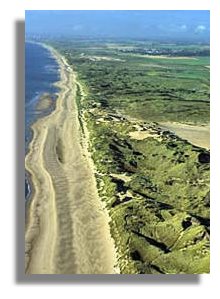 Despite the strenuous objections of environmental groups, the Scottish Government has decided to grant outline planning permission for the application by the organisation headed by US entrepreneur Donald Trump to develop a golf resort at Balconies, Aberdeenshire. It is subject to satisfactory conclusion of legal agreements between the applicant and Aberdeenshire Council. The decision follows receipt by Ministers of a report from the Reporters at the public local inquiry recommending that outline planning permission be granted. The Reporters found there was significant economic and social benefit to be gained from this project, which has been a major consideration in the ministerial decision to grant outline planning permission. The proposal (estimated to cost around a billion pounds) involves the development of a golf resort, including two 18-hole golf courses with associated clubhouse, starter's hut, caddy shack, short-game practice area and driving range, together with a 450-bedroom hotel with conference centre and spa, 950 holiday apartments in four blocks, 36 golf villas, 500 houses for sale, accommodation for 400 staff and a new access onto the A90 trunk road. But it will encroach on protected sand dunes and a site of special scientific interest. The project had the backing of the Scottish First Minister who is also the Member of the Scottish Parliament where the development is to be created. He said after the decision had been announced: "In tough economic times, substantial investment of this kind is at a premium. 6,000 jobs, including 1,400 which will be local and permanent, is a powerful argument." He added that the proposal would never have been made but for the outstanding "natural beauty" of the area. Work on the massive development could start on site as early as next spring.
Despite the strenuous objections of environmental groups, the Scottish Government has decided to grant outline planning permission for the application by the organisation headed by US entrepreneur Donald Trump to develop a golf resort at Balconies, Aberdeenshire. It is subject to satisfactory conclusion of legal agreements between the applicant and Aberdeenshire Council. The decision follows receipt by Ministers of a report from the Reporters at the public local inquiry recommending that outline planning permission be granted. The Reporters found there was significant economic and social benefit to be gained from this project, which has been a major consideration in the ministerial decision to grant outline planning permission. The proposal (estimated to cost around a billion pounds) involves the development of a golf resort, including two 18-hole golf courses with associated clubhouse, starter's hut, caddy shack, short-game practice area and driving range, together with a 450-bedroom hotel with conference centre and spa, 950 holiday apartments in four blocks, 36 golf villas, 500 houses for sale, accommodation for 400 staff and a new access onto the A90 trunk road. But it will encroach on protected sand dunes and a site of special scientific interest. The project had the backing of the Scottish First Minister who is also the Member of the Scottish Parliament where the development is to be created. He said after the decision had been announced: "In tough economic times, substantial investment of this kind is at a premium. 6,000 jobs, including 1,400 which will be local and permanent, is a powerful argument." He added that the proposal would never have been made but for the outstanding "natural beauty" of the area. Work on the massive development could start on site as early as next spring.
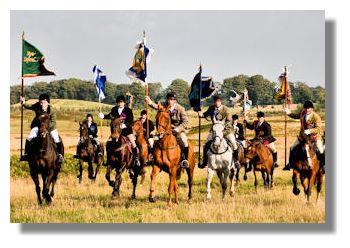 Since the beginning of the 16th Century, Common Ridings & Festivals have formed an integral part of Scottish Borders tradition. An annual celebration, Common Riding combines horsemanship with incredible tradition.
The centuries-old Scottish Borders Common Ridings & Festivals have joined together to support Scotland’s first national Homecoming celebration by issuing a joint invitation to Border folk around the globe to "Return to the Ridings in 2009." Eleven towns in the Scottish Borders are involved and Borders folk who have emigrated are invited to rekindle their interest in their ancestral town by participating in these spectacular local events. For more information, see
Since the beginning of the 16th Century, Common Ridings & Festivals have formed an integral part of Scottish Borders tradition. An annual celebration, Common Riding combines horsemanship with incredible tradition.
The centuries-old Scottish Borders Common Ridings & Festivals have joined together to support Scotland’s first national Homecoming celebration by issuing a joint invitation to Border folk around the globe to "Return to the Ridings in 2009." Eleven towns in the Scottish Borders are involved and Borders folk who have emigrated are invited to rekindle their interest in their ancestral town by participating in these spectacular local events. For more information, see  Ten famous Scots combine to present the anthem "Caledonia" against the background of iconic Scottish scenery. The 60-second advert includes Sir Sean Connery, Lulu, Amy Macdonald, Sandi Thom, Eddi Reader, Brian Cox, golfer Sam Torrance, triple Olympic champion Chris Hoy, and international rugby players Thom Evans and Kelly Brown. It has to be said that only some of those appearing can sing in tune - and Sir Sean steadfastly speaks his lines. The advert will be screened regularly over the next week to raise awareness in Homecoming Scotland 2009 and encourage Scots to invite friends and family to return home for the celebrations. Introducing the film clip, First Minister Alex Salmond said: "Caledonia is a song that resonates with Scots the world over. For those far away it is a reminder of strong bonds, full of the promise of return. That is what makes it the perfect anthem for our Year of Homecoming. Next year we will be celebrating the 250th anniversary of our national bard, Robert Burns, who himself wrote a song for his native Caledonia. With over 200 events nationwide to mark this occasion, this advert will sing to Scots about what we have to celebrate." To view the video, see
Ten famous Scots combine to present the anthem "Caledonia" against the background of iconic Scottish scenery. The 60-second advert includes Sir Sean Connery, Lulu, Amy Macdonald, Sandi Thom, Eddi Reader, Brian Cox, golfer Sam Torrance, triple Olympic champion Chris Hoy, and international rugby players Thom Evans and Kelly Brown. It has to be said that only some of those appearing can sing in tune - and Sir Sean steadfastly speaks his lines. The advert will be screened regularly over the next week to raise awareness in Homecoming Scotland 2009 and encourage Scots to invite friends and family to return home for the celebrations. Introducing the film clip, First Minister Alex Salmond said: "Caledonia is a song that resonates with Scots the world over. For those far away it is a reminder of strong bonds, full of the promise of return. That is what makes it the perfect anthem for our Year of Homecoming. Next year we will be celebrating the 250th anniversary of our national bard, Robert Burns, who himself wrote a song for his native Caledonia. With over 200 events nationwide to mark this occasion, this advert will sing to Scots about what we have to celebrate." To view the video, see 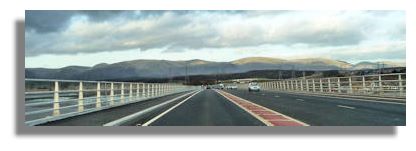 First Minister Alex Salmond officially opened the new £120 million Clackmannanshire bridge, crossing in a convoy of vehicles including an electric car and a bicycle - paying lip service to environmental considerations. The new bridge will remove congestion in the town of Kincardine, where the present Kincardine Bridge reaches Fife. Over 30,000 vehicles use that crossing and the Clackmannanshire Bridge will cut that volume to 18,000. The impact of the new crossing will be even more dramatic on Kincardine itself, where traffic volumes are expected to drop to 20% of the previous level.
First Minister Alex Salmond officially opened the new £120 million Clackmannanshire bridge, crossing in a convoy of vehicles including an electric car and a bicycle - paying lip service to environmental considerations. The new bridge will remove congestion in the town of Kincardine, where the present Kincardine Bridge reaches Fife. Over 30,000 vehicles use that crossing and the Clackmannanshire Bridge will cut that volume to 18,000. The impact of the new crossing will be even more dramatic on Kincardine itself, where traffic volumes are expected to drop to 20% of the previous level.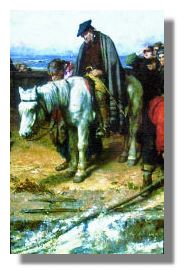 The new Scottish Centre for Diaspora Studies at Edinburgh University opened this week, aiming to investigate the impact made by thousands of Scottish emigrants from medieval times to the present day. The centre was established thanks to a donation of £1 million by Alan McFarlane, managing director of investment management firm Walter Scott and Partners and a former student at the university. Professor Tom Devine, the Scottish historian, will head the new centre which will research how Scots influenced societies, economies, and cultures around the world - not just the New Worlds of Australia, New Zealand and North America, but also in Asia and in countries such as Sweden, Poland, and France. From the 1850s to the Second World War, Scotland was one of the top three nations in Europe in terms of emigration. Because Scotland in the 18th and 19th centuries had a disproportionate number of semi-skilled, skilled, and professional emigrants, they tended to have a disproportionate impact on their countries of settlement.
The new Scottish Centre for Diaspora Studies at Edinburgh University opened this week, aiming to investigate the impact made by thousands of Scottish emigrants from medieval times to the present day. The centre was established thanks to a donation of £1 million by Alan McFarlane, managing director of investment management firm Walter Scott and Partners and a former student at the university. Professor Tom Devine, the Scottish historian, will head the new centre which will research how Scots influenced societies, economies, and cultures around the world - not just the New Worlds of Australia, New Zealand and North America, but also in Asia and in countries such as Sweden, Poland, and France. From the 1850s to the Second World War, Scotland was one of the top three nations in Europe in terms of emigration. Because Scotland in the 18th and 19th centuries had a disproportionate number of semi-skilled, skilled, and professional emigrants, they tended to have a disproportionate impact on their countries of settlement. 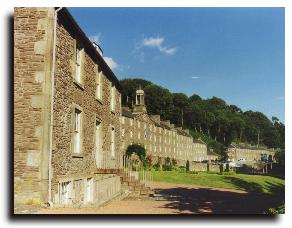 The chairman of the charitable trust which takes care of the 18th century cotton mill at New Lanark has warned that the current economic turmoil is impacting on the Unesco World Heritage site and that vital repair work is being delayed. The New Lanark site has recently had an application rejected for a National Heritage Lottery Grant which would have been used to stop a crumbling wall collapsing. Scottish Culture Minister Linda Fabiani has agreed to meet the chairman of New Lanark Trust to discuss the challenges facing the site.
The chairman of the charitable trust which takes care of the 18th century cotton mill at New Lanark has warned that the current economic turmoil is impacting on the Unesco World Heritage site and that vital repair work is being delayed. The New Lanark site has recently had an application rejected for a National Heritage Lottery Grant which would have been used to stop a crumbling wall collapsing. Scottish Culture Minister Linda Fabiani has agreed to meet the chairman of New Lanark Trust to discuss the challenges facing the site.

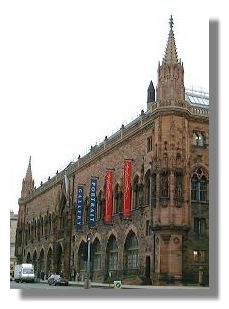 The plans for a major revamp of the historic Scottish National Portrait Gallery in Edinburgh is about to get the go-ahead from the city planning authorities. The £17.6 million plan will strip away many of the changes that have been made since the building opened 120 years ago as the first purpose-built portrait gallery in the world. Many of the original features such as sandstone arches will be revealed again and gallery space will be increased by 50% The gallery will close for two years to allow the work to proceed. It is hoped that the end result will increase visitor numbers to around 300,000 a year.
The plans for a major revamp of the historic Scottish National Portrait Gallery in Edinburgh is about to get the go-ahead from the city planning authorities. The £17.6 million plan will strip away many of the changes that have been made since the building opened 120 years ago as the first purpose-built portrait gallery in the world. Many of the original features such as sandstone arches will be revealed again and gallery space will be increased by 50% The gallery will close for two years to allow the work to proceed. It is hoped that the end result will increase visitor numbers to around 300,000 a year.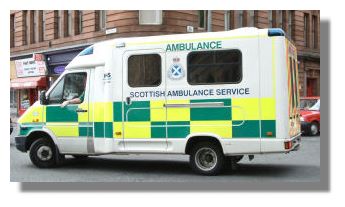 The cold weather and icy, slippery pavements and car parks have produced a spate of people with broken wrists, ankles, elbows and legs. The accident and emergency departments in Glasgow and Clyde recorded their busiest day ever on the first Tuesday in December. Almost 2,000 patients were seen in one day, a 20% rise on the previous highest record. Fortunately, the severe weather warnings issued by the meteorological office for a heavy fall of snow towards the end of the first week of December didn't materialise, otherwise the number of accidents would have continued at a high level. Although the roads departments claimed that they had gritted all the main roads, it was suburban side roads that often went untreated and pedestrian areas were often left with hard packed snow and ice.
The cold weather and icy, slippery pavements and car parks have produced a spate of people with broken wrists, ankles, elbows and legs. The accident and emergency departments in Glasgow and Clyde recorded their busiest day ever on the first Tuesday in December. Almost 2,000 patients were seen in one day, a 20% rise on the previous highest record. Fortunately, the severe weather warnings issued by the meteorological office for a heavy fall of snow towards the end of the first week of December didn't materialise, otherwise the number of accidents would have continued at a high level. Although the roads departments claimed that they had gritted all the main roads, it was suburban side roads that often went untreated and pedestrian areas were often left with hard packed snow and ice. A new report has highlighted that room prices at Scottish hotels have fallen by up to 15% (in Inverness) in the last year. Edinburgh prices fell by 5% (to an average of £106 per night) while Glasgow remained the best value with rooms down in price by 3% to an average of £77 per night. Hoteliers expect that they will be forced to introduce even more competitive prices next year as people look for more for low cost accommodation. In Edinburgh, massive discounts are on offer in some of the exclusive hotels - The Glasshouse has cut more than 50% from some of its prices.
A new report has highlighted that room prices at Scottish hotels have fallen by up to 15% (in Inverness) in the last year. Edinburgh prices fell by 5% (to an average of £106 per night) while Glasgow remained the best value with rooms down in price by 3% to an average of £77 per night. Hoteliers expect that they will be forced to introduce even more competitive prices next year as people look for more for low cost accommodation. In Edinburgh, massive discounts are on offer in some of the exclusive hotels - The Glasshouse has cut more than 50% from some of its prices.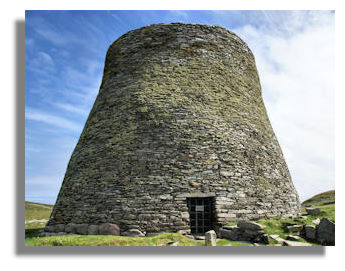 A museum in Caithness, in the far north of mainland Scotland, is being upgraded and is to change its name from the Northlands Viking Centre to the Caithness Broch Centre. The new name is to reflect the large number of brochs - 2,000-year-old stone towers - which can be found in the area. There are more brochs per square mile in Caithness than any other part of Scotland. When the refurbishment is completed in the spring, the centre will display artefacts from Caithness's past, including Vikings. A Broch is an Iron Age drystone hollow-walled structure of a type found only in Scotland. Brochs include some of the most sophisticated examples of drystone architecture ever created.
A museum in Caithness, in the far north of mainland Scotland, is being upgraded and is to change its name from the Northlands Viking Centre to the Caithness Broch Centre. The new name is to reflect the large number of brochs - 2,000-year-old stone towers - which can be found in the area. There are more brochs per square mile in Caithness than any other part of Scotland. When the refurbishment is completed in the spring, the centre will display artefacts from Caithness's past, including Vikings. A Broch is an Iron Age drystone hollow-walled structure of a type found only in Scotland. Brochs include some of the most sophisticated examples of drystone architecture ever created.
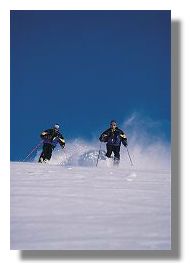 The White Corries ski centre near Glencoe is planning to expand its facilities to become a year-round visitor attraction, with activities such as zip wire, rock-climbing and a paragliding base. Situated just 75 miles north of Glasgow, the resort covers nearly 500 acres and has seven lifts and 19 runs - if it snows. It is already a major paragliding destination and 50,000 walkers go past the centre each year on the West Highland Way which runs from north of Glasgow to Fort William. Last August the centre hosted its first Scottish Downhill Association Mountain Bike Championship race and more of these are planned. The team running the resort think that the current credit crunch could be a positive for Scottish skiing as the stronger Euro will discourage overseas trips. The White Corries ski centre is regarded as the first in Scotland due to the construction of the first overhead ski lift there in 1956.
The White Corries ski centre near Glencoe is planning to expand its facilities to become a year-round visitor attraction, with activities such as zip wire, rock-climbing and a paragliding base. Situated just 75 miles north of Glasgow, the resort covers nearly 500 acres and has seven lifts and 19 runs - if it snows. It is already a major paragliding destination and 50,000 walkers go past the centre each year on the West Highland Way which runs from north of Glasgow to Fort William. Last August the centre hosted its first Scottish Downhill Association Mountain Bike Championship race and more of these are planned. The team running the resort think that the current credit crunch could be a positive for Scottish skiing as the stronger Euro will discourage overseas trips. The White Corries ski centre is regarded as the first in Scotland due to the construction of the first overhead ski lift there in 1956.

